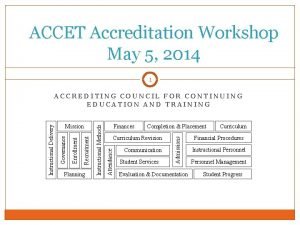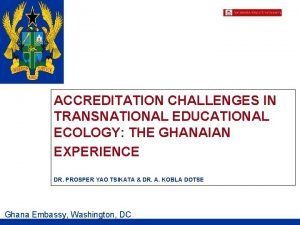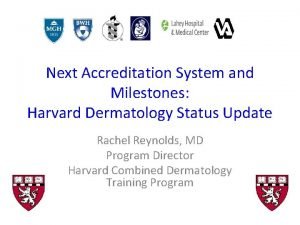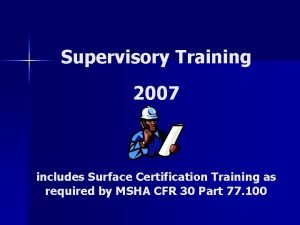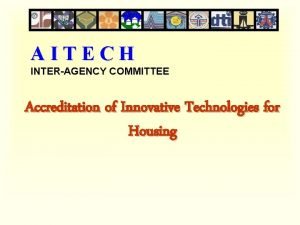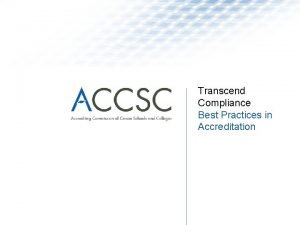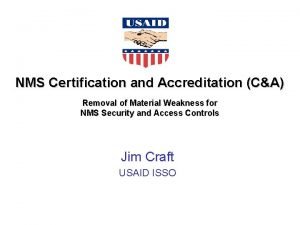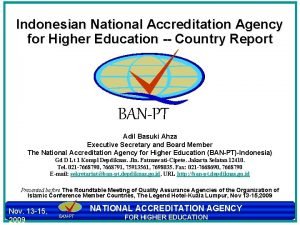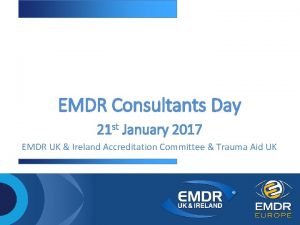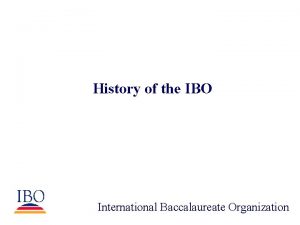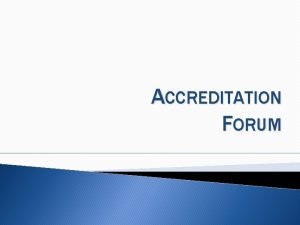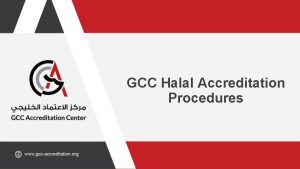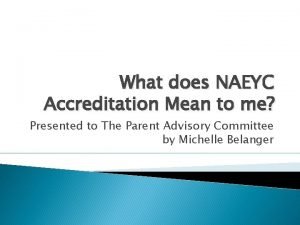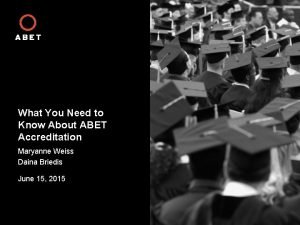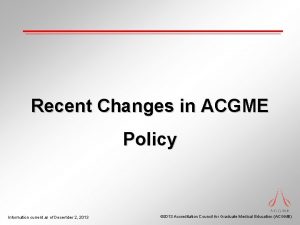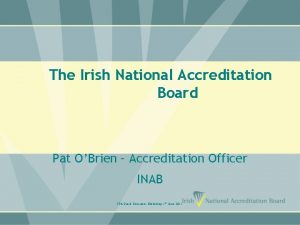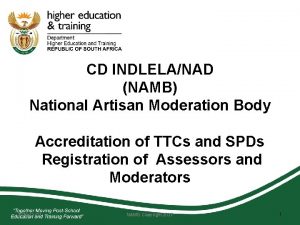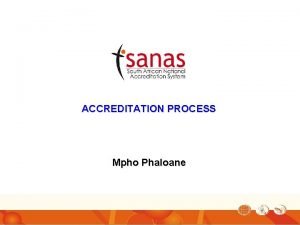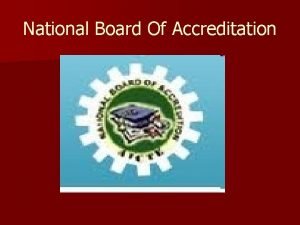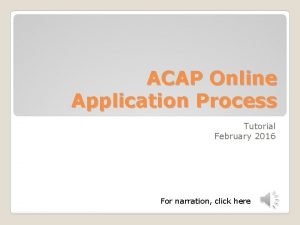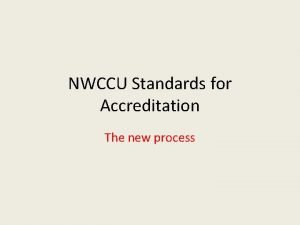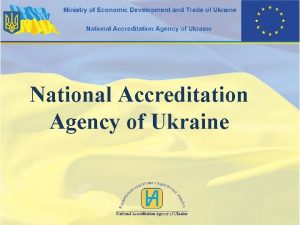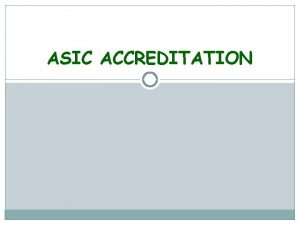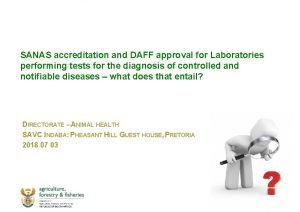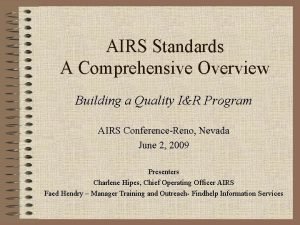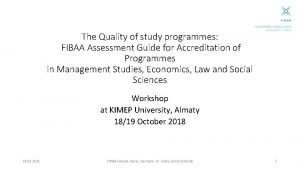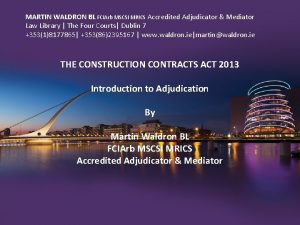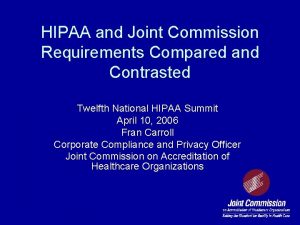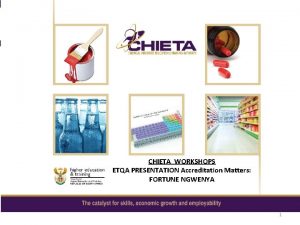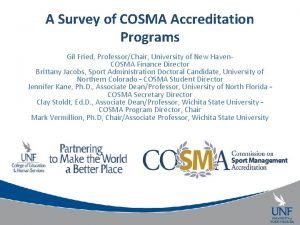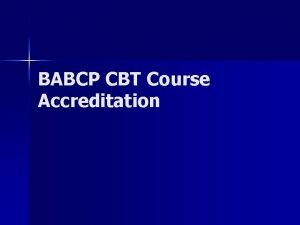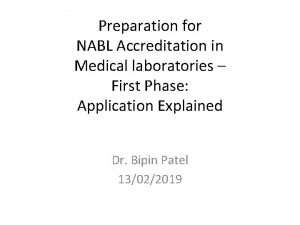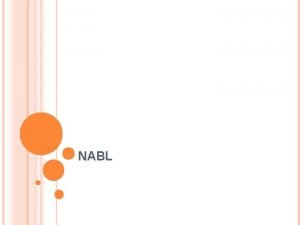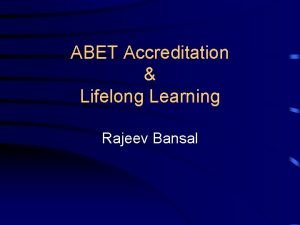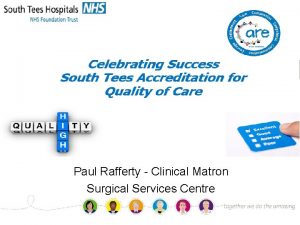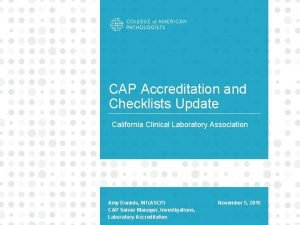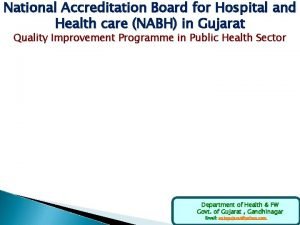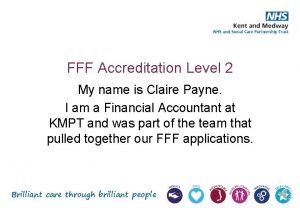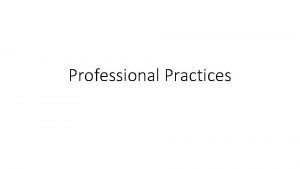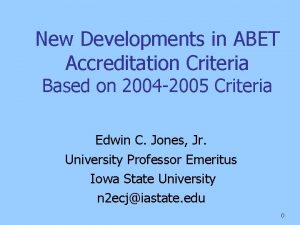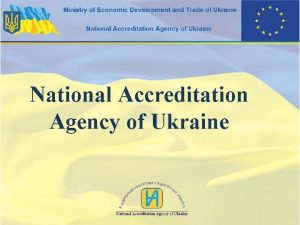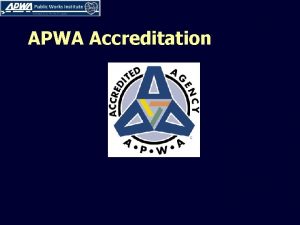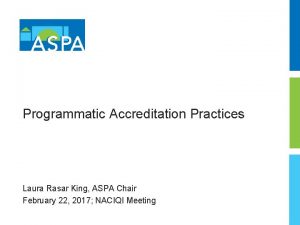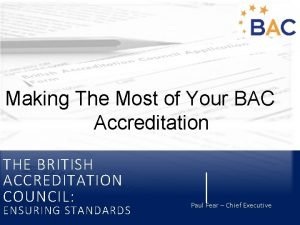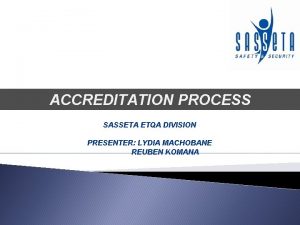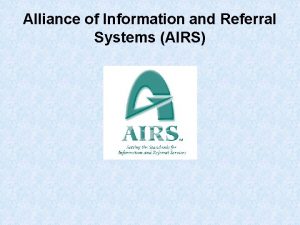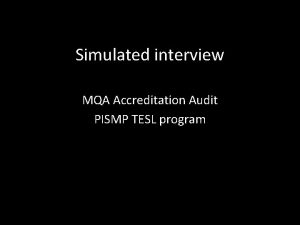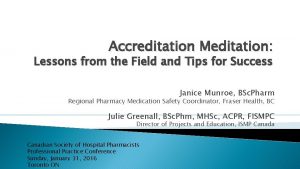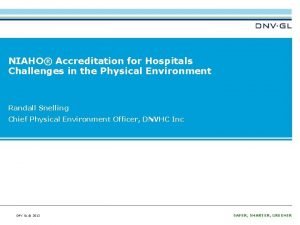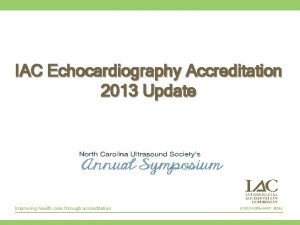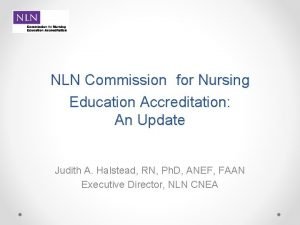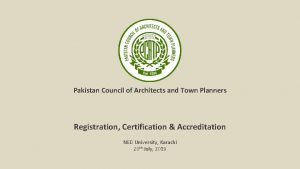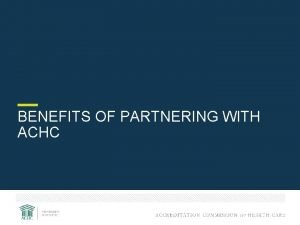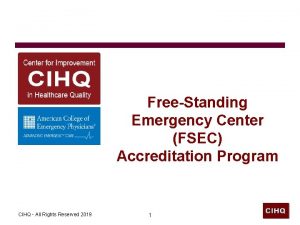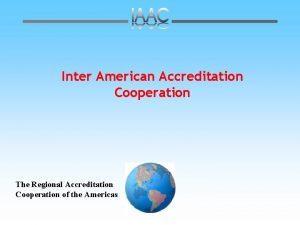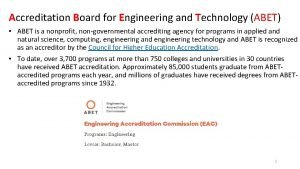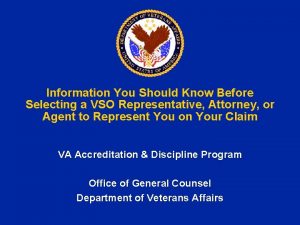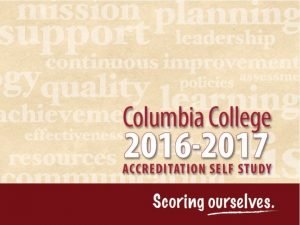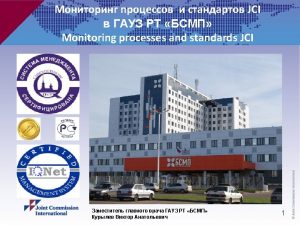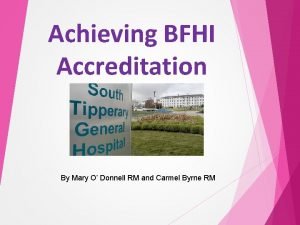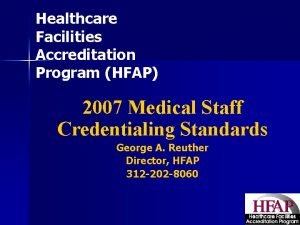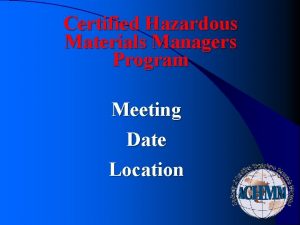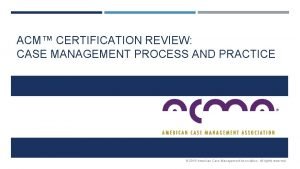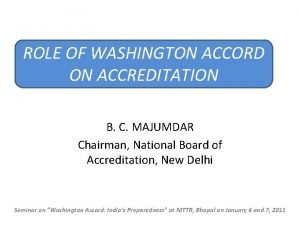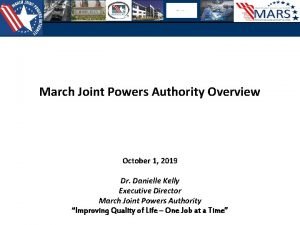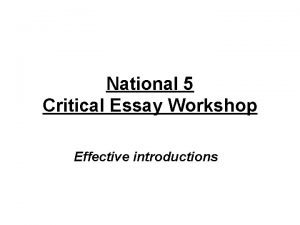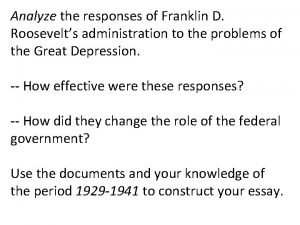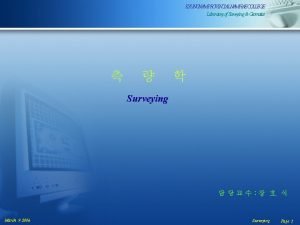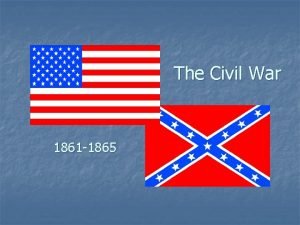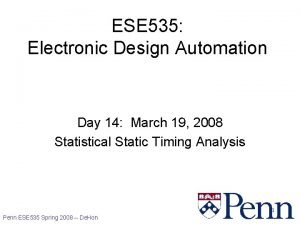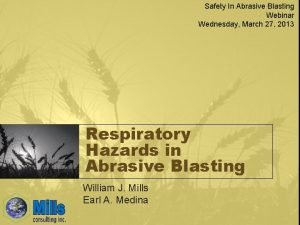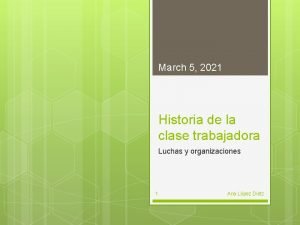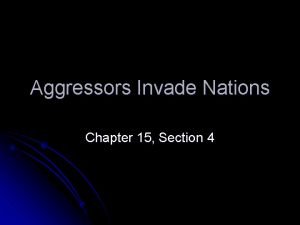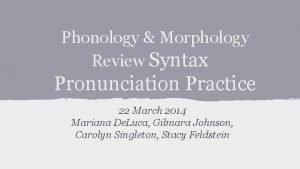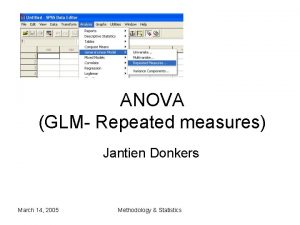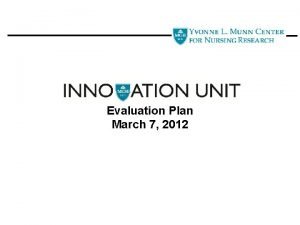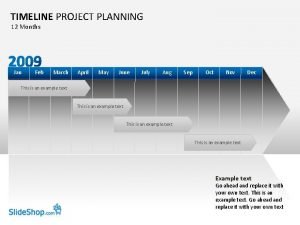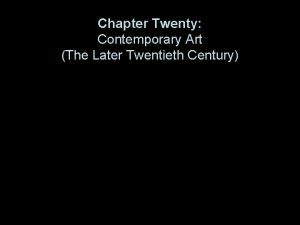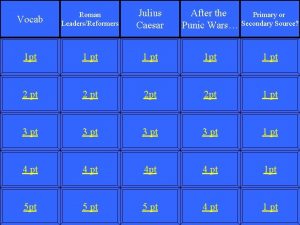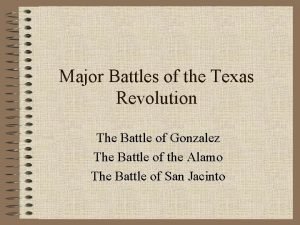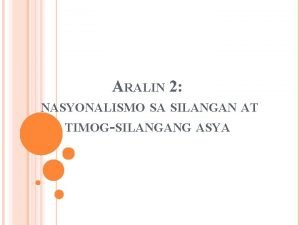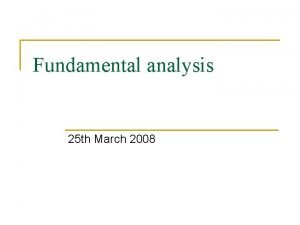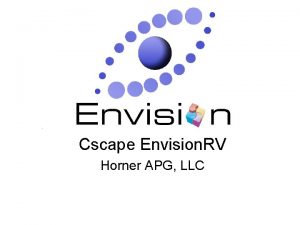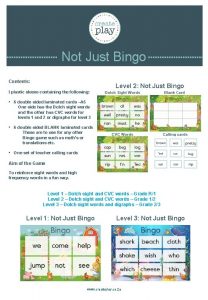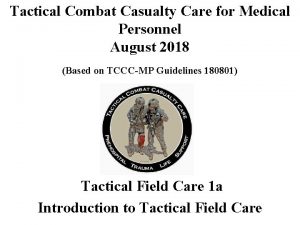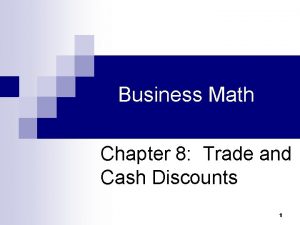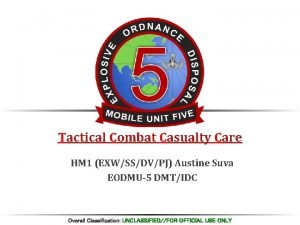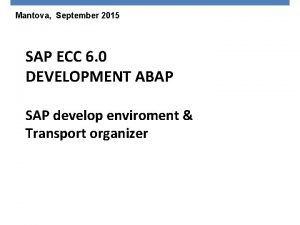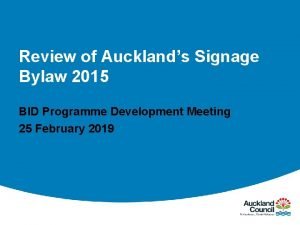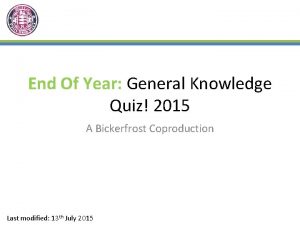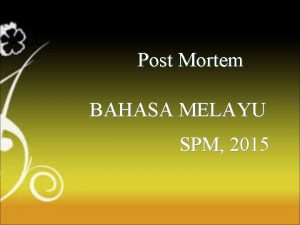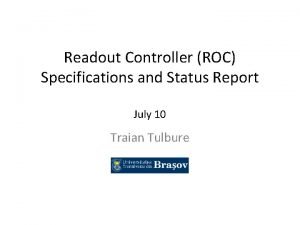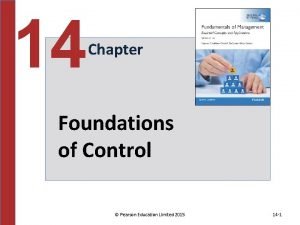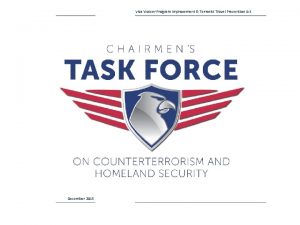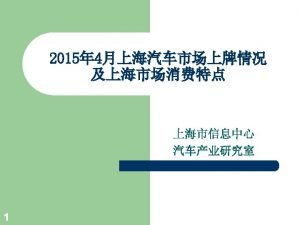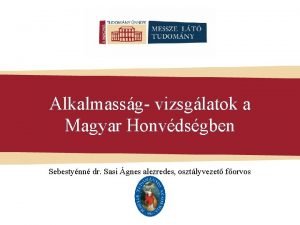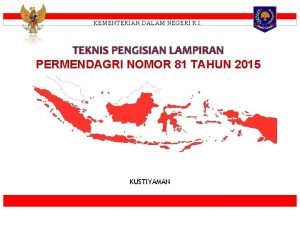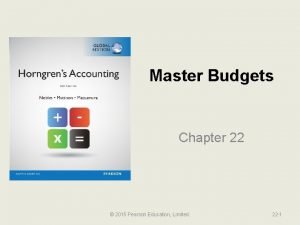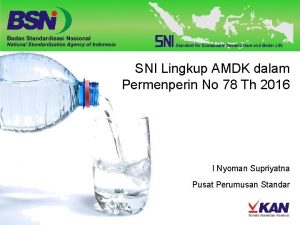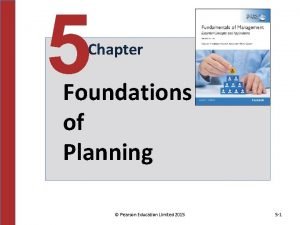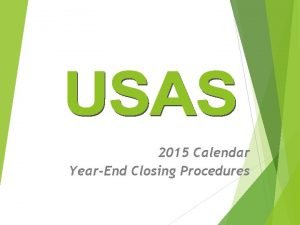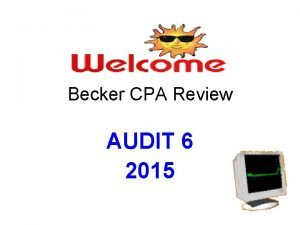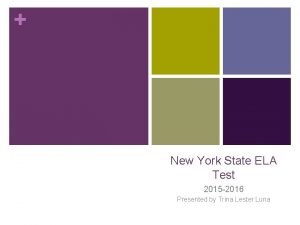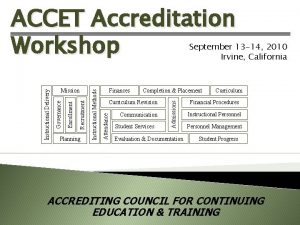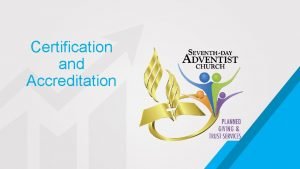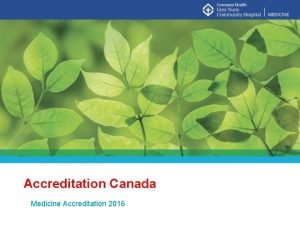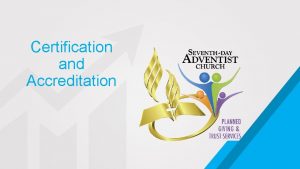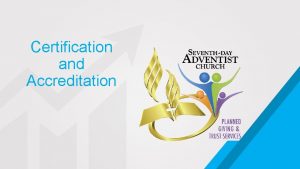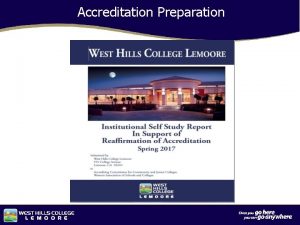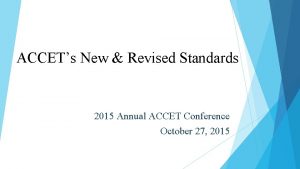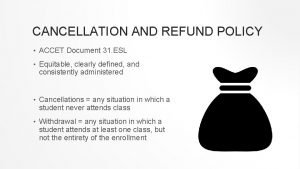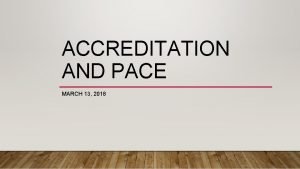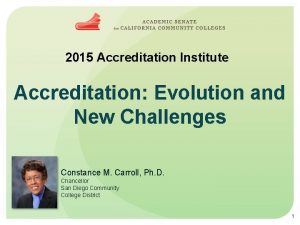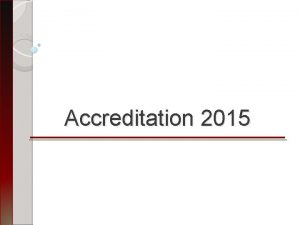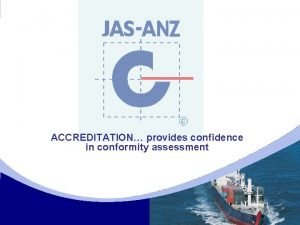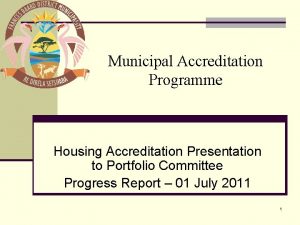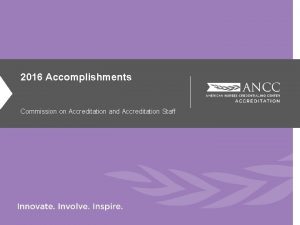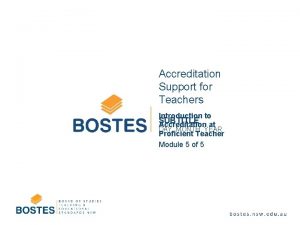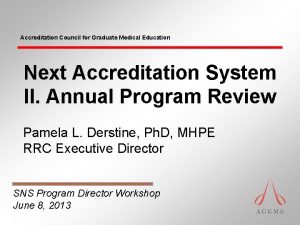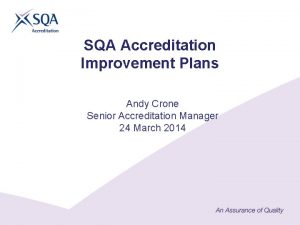ACCET Accreditation Workshop March 9 10 2015 1


























































































































































































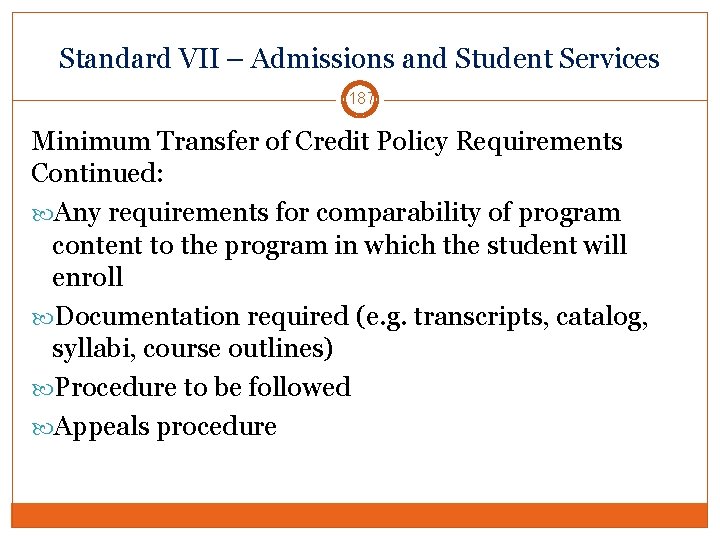
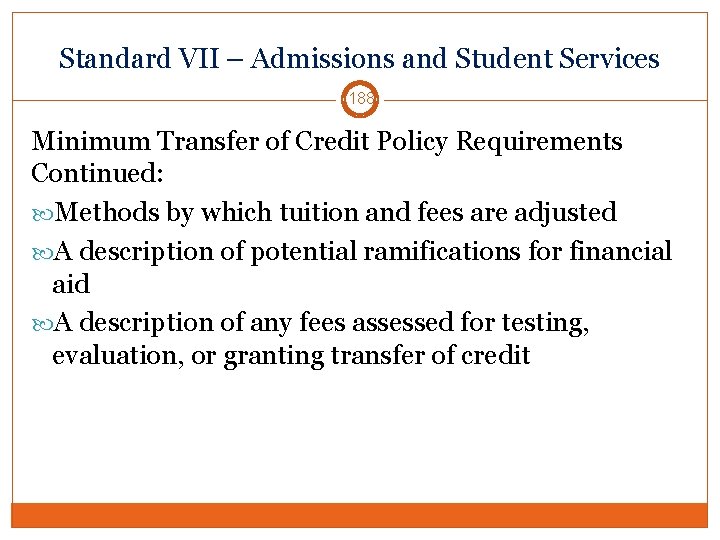
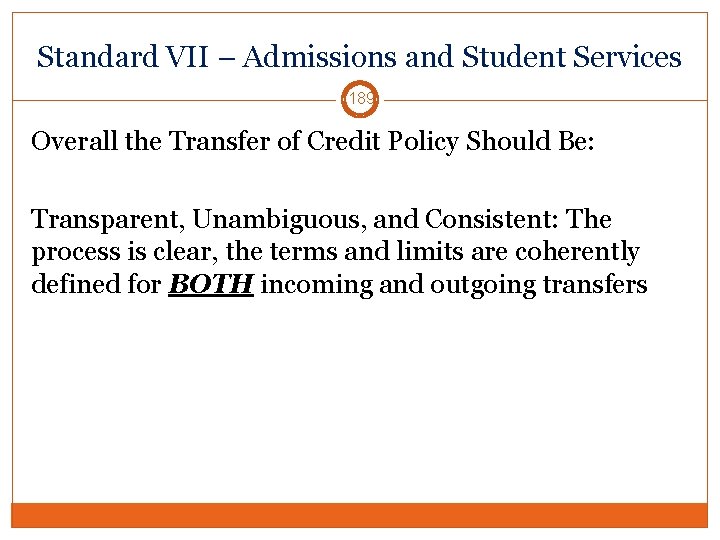
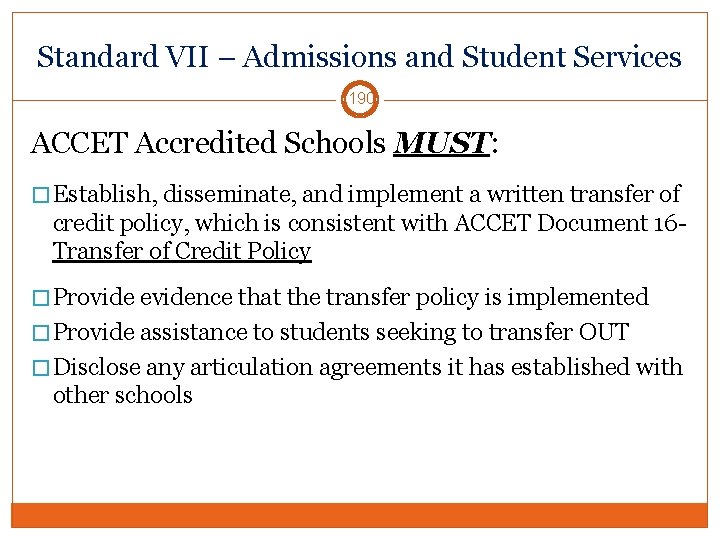
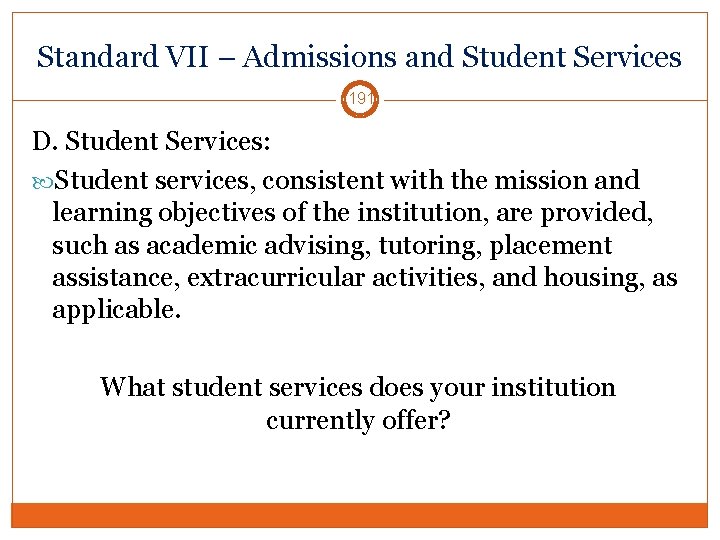
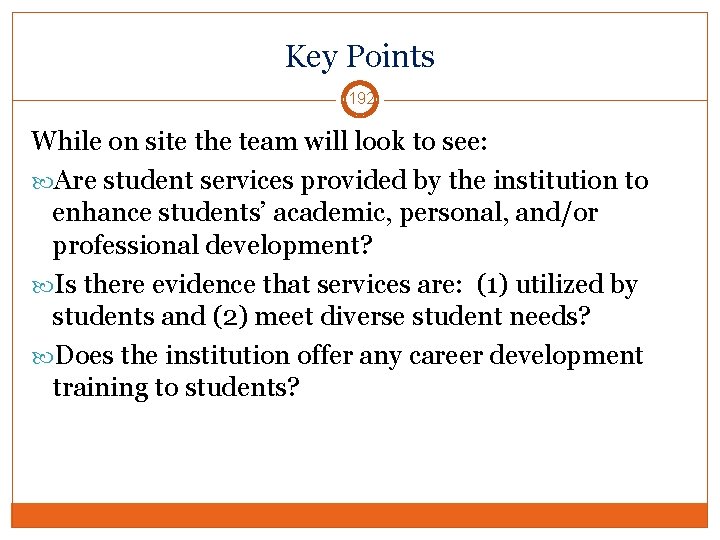
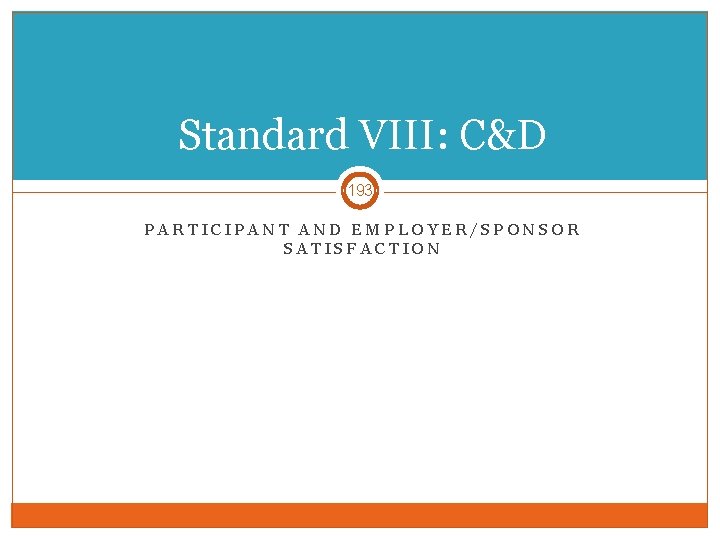
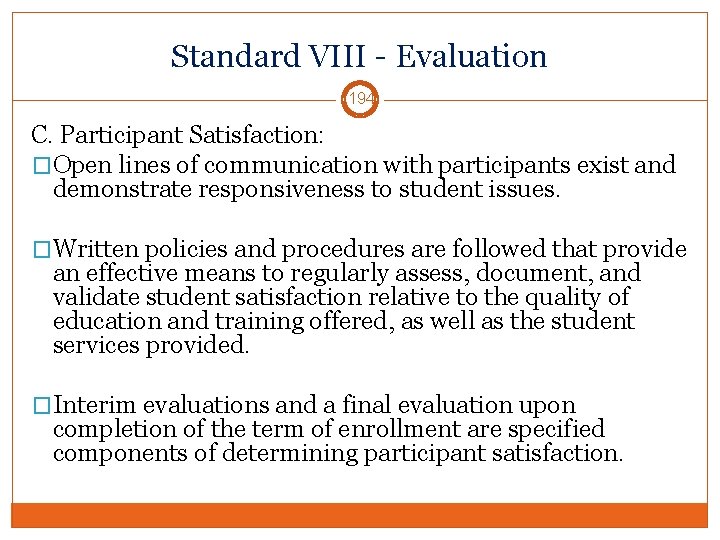
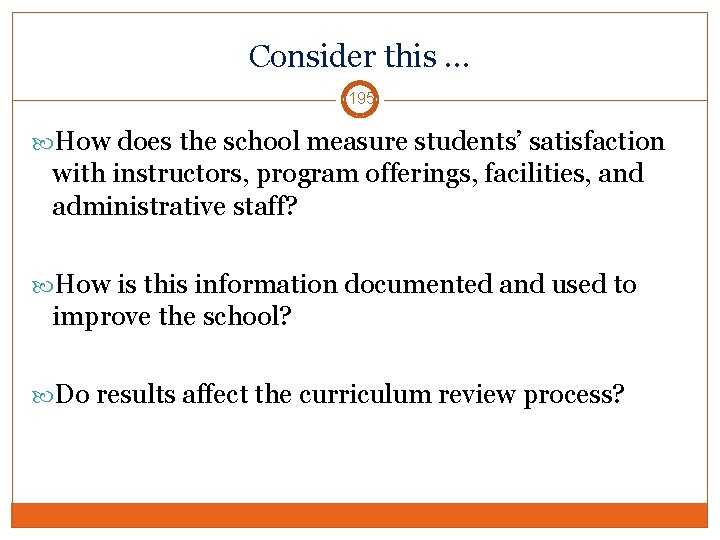
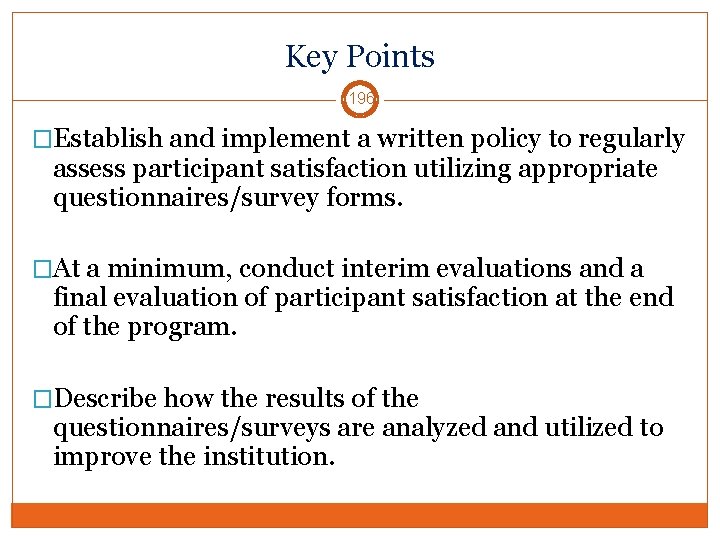
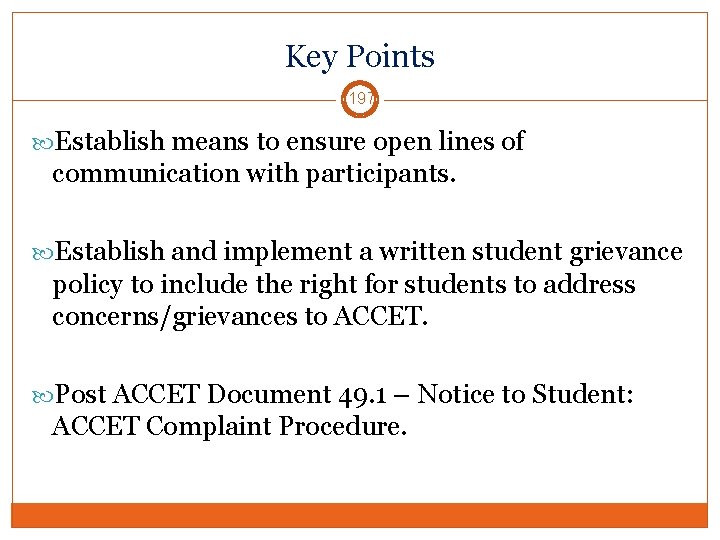
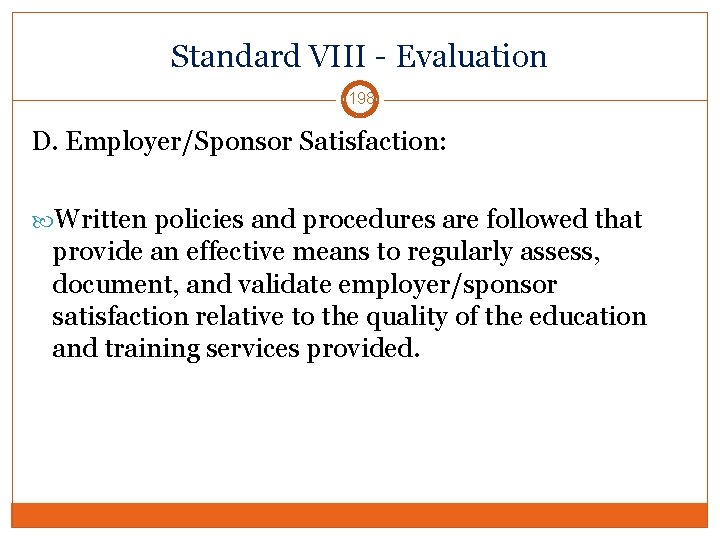
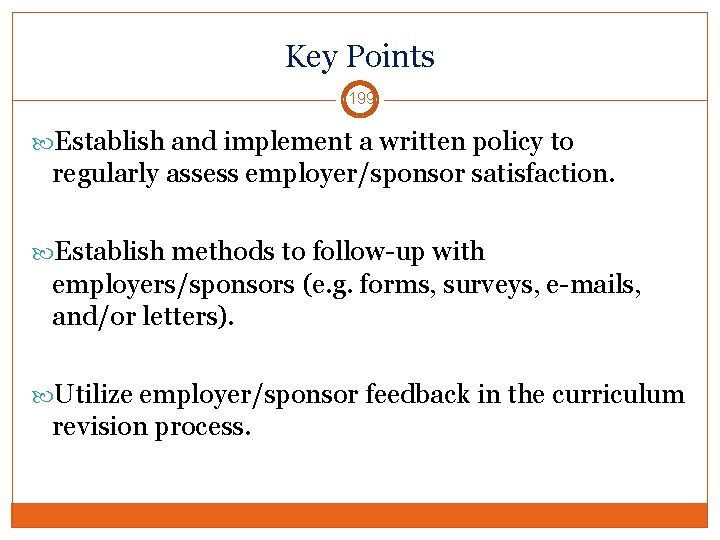
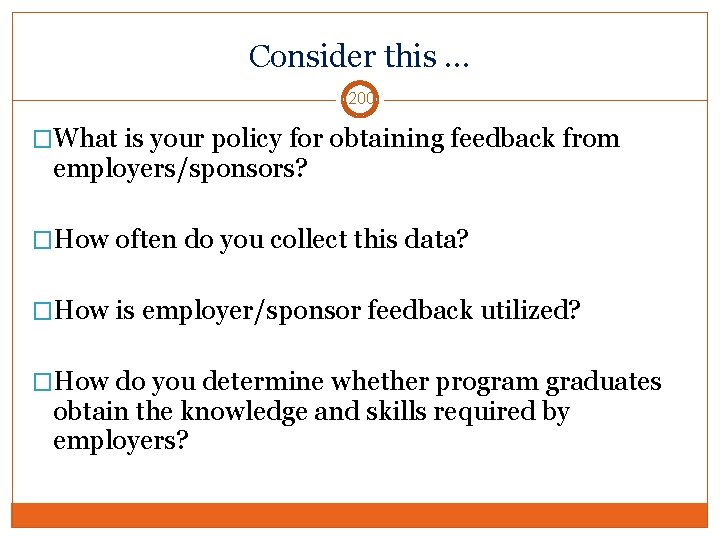
- Slides: 200

ACCET Accreditation Workshop March 9 - 10, 2015 1 Completion & Placement Curriculum Revision Communication Student Services Admissions Finances Attendance Planning Instructional Methods Recruitment Enrollment Mission Governance Instructional Delivery ACCREDITING COUNCIL FOR CONTINUING EDUCATION AND TRAINING Evaluation & Documentation Curriculum Financial Procedures Instructional Personnel Management Student Progress

Introduction to ACCET Staff 2 Bill Larkin - Executive Director Judy Hendrickson – Deputy Executive Director Commission Liaison: Standards & Policy Review Committee Commission Liaison: Appeals Panel ISO 9001: 2008 Manager John Shaheen – Associate Executive Director Chair: Change of Ownership Review Committee Linsay Oakden – Assistant Executive Director Commission Liaison: Completion & Placement Review Committee Chair: On-Site Review

Introduction to ACCET Staff 3 Scott Faulstick - Senior Accreditation Coordinator Co-Chair: Application Review Committee (Initial) John Gregg – Senior Accreditation Coordinator Chair: Program Review Committee Eric Lee - Accreditation Coordinator Chair: Application Review Committee (Reaccreditation) Megan Ackerman-Yost – Accreditation Coordinator Commission Liaison: Financial Review Committee Commission Liaison: Growth Monitoring Committee Jim Doran – Senior Accreditation Coordinator Chair: Branching Review Committee

Introduction to ACCET Staff 4 Anneka Swamy Operations Administrator Meagan Paulk Administrative Assistant AMS Liaison Grace Kye Administrative Assistant

Contracted ACCET Personnel 5 Commission Representatives (Off-Site): Carol Buchanan George Carter Donna Hutchison Charlie Matterson Chair – Complaint Review Committee (Off-Site) Matthew Nistico

Introduction by Attendees 6 Name Institutional affiliation, city, state Type of training Initial Accreditation/Reaccreditation

Overview 7 Establishment of Agency Established in 1974 as a private, non-profit 501(c)(3) corporation by a group of continuing education providers. Diversity/Scope of Membership Approximately 730 training sites 1/3 vocational 1/3 Intensive English Programs 1/3 avocational/professional development Members offering continuing education, certificate programs, Occupational Associate Degrees (OAD) in both classroom and interactive distance education (IDL) modalities.

Overview 8 Recognition of ACCET Officially recognized by the U. S. Department of Education since 1978 as a “reliable authority as to the quality of education or training provided by the institutions of higher education and the programs they accredit. ” ACCET received the maximum 5 -year grant of continued recognition in its prior evaluation, following the review and recommendation of the Department’s National Advisory Committee for Instructional Quality and Integrity. ACCET certified under ISO 9001: 2008 international standards as a Quality Management System through annual on-site evaluations conducted since 1998.

Overview Institutional Accreditation 9 ACCET evaluates institutions/organizations offering postsecondary education and training below the bachelor’s degree level, except in the case of stand-alone departments or divisions, such as continuing education or intensive English programs, within a higher education institution. Peer Review /Colleagues Member institutions viewed as colleagues, not customers, and the public interest is both primary and complementary to ACCET’s mission.

Overview 10 ACCET Accrediting Commission An autonomous twelve-member Accrediting Commission, with eight institutional (elected) members, and four public (appointed) members, has ultimate authority over ACCET activities ACCET Peer Review Volunteers A cadre of over 275 professionals from various fields within postsecondary education and training serving on special committees, panels, and on-site teams work to maintain the contemporary perspective on good practices. ACCET Staff Twelve staff and four contract field representatives conduct the day -to-day operations under the authority delegated to the Executive Director.

Overview 11 Self-Regulation Accreditation is a non-governmental, voluntary oversight process to assess and enhance the integrity and quality of education/training offered by postsecondary institutions. We are a voluntary affiliation of organizations committed to self-regulation through independent peer-review and evaluation. A reliable methodology is utilized to evaluate operational functions for systematic and effective implementation and to identify areas for institutional self-improvement.

Overview 12 Standards, Policies and Procedures Standards for Accreditation (Document 2) are the guiding criteria under which the Accrediting Commission exercises its professional judgment of the evaluation of institutions seeking accredited status with ACCET. The five year Standard Review Process is currently underway, involving schools, the public, outside agencies, staff, and students. Policies and procedures are adopted by the Accrediting Commission, following appropriate call-for-comment, to guide and facilitate the interpretation and application of standards focused on sound operational practices.

Purpose and Benefit of Accreditation 13 Quality Assurance As “A Partnership for Quality®”: the ACCET accreditation process represents an organizational commitment to standards, practices, and processes focused on operational integrity and quality training. This peer review evaluation process serves to identify, direct and inspire continuing education and training that is current, relevant, and educationally sound.

Purpose and Benefit of Accreditation 14 Gatekeeper Functions � Title IV Funding Department of Homeland Security � Institutions offering Intensive English Programs are now required to be accredited to receive authorization from the Student Exchange and Visitors Program (SEVP) to enroll non-immigrant students under F, M, and J visas. Department of Defense Programs � Accredited institutions offering vocational programs are eligible to seek approval from USDE for federal student financial aid for their students. Tuition reimbursement for military personnel is limited to enrollment at postsecondary institutions accredited by agencies recognized by USDE. State and Local Funding Programs Accreditation assists institutions in pursuing contractual affiliations with welfare, rehabilitation, and other workforce development programs.

Purpose and Benefit of Accreditation 15 � Training Contracts Accreditation assists institutions seeking contracts with corporations and government agencies, which often require accreditation as a condition to bid on training proposals. � Directory/Website Listings ACCET accredited institutions are listed in the following directories utilized by corporate, government, and military agencies to identify credible educational organizations when establishing tuition reimbursement policies: American Council on Education (ACE) directory of Accredited Institutions of Postsecondary Education � Council for Higher Education Accreditation (CHEA) website at www. chea. org/search � U. S. Department of Education � � edu Domain: Accreditation permits institutions to file with Educause for the use of the. edu domain for email and website addresses.

Success in the Process 16 Maintain an institutional-wide commitment to the quality standards to ensure systematic and effective implementation in practice. Emphasize outcomes – achieving specified learning goals Strive for continuous improvement through ongoing internal review

ACCREDITATION Schedule and General Overview 17

Accreditation Process/Timeframe (Approximately 12 months) 18 Initial Inquiry submitted electronically by institution Initial Inquiry reviewed by staff Application (Doc. 4) submitted electronically by institution Application reviewed by ACCET staff (2 -4 Months) Additional information requested by ACCET (if necessary)

Accreditation Process/Timeframe (Approximately 12 months) 19 Once Accepted – Accreditation cycle assigned and all other cycle dates are determined Attendance at Accreditation Workshop Readiness Visit: Required for all initial applicants Preparation & submission of electronic Analytic Self. Evaluation Report (ASER) by institution

Accreditation Process/Timeframe (Approximately 12 months) 20 On-site team visit & Team Report (2 -day visit & Team Report sent within 30 days of visit) Institution’s response to Team Report (due within 14 days) Accrediting Commission’s review and decision Commission letter (within 30 days of Commission Meeting)

Readiness Visit 21 � Purpose: Assist initial applicants in the preparation of their ASER materials and full on-site evaluation visit. � Requirements: Complete and submit ACCET Document 8 Submit the Readiness Visit Fee of $1, 900 Prepare and submit a draft copy of the ASER � Process: Tour facility Review ASER and exhibits Review policies and procedures Provide guidance to the institutions, as needed � Plan Ahead * -- Allow ample time for ACCET to schedule and conduct the Readiness Visit.

Fees 22 Initial Application Fee - $2, 000 On-site Visit Fee - Initial $6, 000 – 3 Person Team Reaccreditation Application Fee $1, 000 Vocational Reaccreditation Visit Fee $5, 700 Avocational Reaccreditation Visit Fee $3, 800 Penalties for late reporting and late payments See Document 10 for full fee schedule

Application for Accreditation and Programs 23 DOCUMENT 4

Reaccreditation Review Schedule 24 REACCRED APPLICATION ASER DUE CYCLE BASER (Reaccred) EMAIL DOCUMENT SENT 8 December 12, April 10, 2015 2014 April 10, 2015 August 14, 2015 ON-SITE EVALUATION COMMISSION MEETING DATE July 10, 2015 Sept-Oct, 2015 December 1 -5, 2015 November 13, 2015 Jan-Feb, 2016 April 4 -8, 2016 May-June, 2016 August 1 -5, 2016 Sept-Oct, 2016 Nov 29 – Dec 3, 2016 December 11, March 11, 2016 2015 December 11, April 15, 2016 2015 July 8, 2016

Initial Accreditation Review Schedule 25 Application READINESS VISIT (RV) Approval Date March 6, 2015 ASER BASER DOCUMENT 8 May-June, 2015 July 10, 2015 July 3, 2015 Sept-Oct, 2015 November 3, 2015 October 30, Jan-Feb, 2016 March 11, 2016 2015 March 4, 2015 May-June, 2016 July 8, 2016 ON-SITE EVALUATION COMMISSION MEETING DATE Sept-Oct, 2015 December 1 -5, 2015 May-June, 2016 April 4 -8, 2016 May-June, 2016 August 1 -5, 2016 Sept-Oct, 2016 Nov 29 -Dec 3, 2016

ACCET Accreditation is Institutional 26 ACCET does not offer programmatic accreditation, or provisional or candidacy status Once accredited, an institution’s programs are “approved”, not accredited

An Accredited Institution Must: 27 Seek and obtain written approval from ACCET before advertising, accepting applications, enrolling or teaching any new or revised curriculum. Notify ACCET , in writing, if any approved program or course is not currently offered and has not been offered or won’t be offered for at least 24 consecutive months. *Any program that cannot be reviewed at the time of an on-site visit will not be considered “approved”.

Program Applications Cannot be Accepted: 28 If the institution is in reaccreditation status (scheduled ASER due date until Commission decision) If the main or branch is under restrictive action with ACCET, the state, or federal agency (deferral, denial, appeal, “show cause”) 12 months from the time of a change of ownership 12 months from receiving initial accreditation

Types of Programs/Classification 29 Avocational/Vocational New Programs/Courses Major Revisions Minor Revisions Distance Learning Programs Associates Degree Programs In Scope Programs Out of Scope Programs

General Program Information 30 Reference Document 25 - Policy on New, Revised, and Existing Programs/Courses for course and program information and what requires ACCET notification What program changes do not require ACCET approval 45 day program approval time for a complete application Programs accepted via email, disk, flash drive, hard copy or ACCET Drop Box.

Overview of Analytic Self. Evaluation Report (ASER) 31 DOCUMENTS: 3. 1, 3. 2, 3. 3, 3. 2/3 ESL (COMBINED) OVERLAY TEMPLATES: 3. ESL, 3. VESL, 3. IDL, 3. OAD, 3. MT, 3. NAH

Developing the ASER 32 Obtain support at the highest level Commit resources Start early Assign a champion

Developing the ASER 33 Involve the entire staff Conduct regular meetings Develop/implement new policies and procedures, as needed Tell the “story” of your institution (facts, strengths, weaknesses)

Developing the ASER 34 Check that AMS is giving you the appropriate ACCET Document 3 Gather supporting documentation Develop the ASER and attach documents EDIT, EDIT ASER tips and tricks (see handout: ACCET Standards: We walk alike, talk alike…) RV visit

Structure of Your ASER Narrative 35 Written narrative addressing the eight standards (33 subsections) Standards that do not apply Documents supplementing narrative response to questions and requirements Representative sample Linked in ASER/BASER narrative Additional Sites Management information (particularly standards I & II) should specifically reference practices at the corporate and campus levels

Structure of Your ASER Narrative Cont… 36 Exhibit notes If the ASER requests an exhibit, please attach it Long narratives that attempt to substitute for an exhibit are difficult for the team members to digest It is sometimes helpful to reference a section of a larger manual. However, this can pose a problem for team members to locate the correct section and page. Best practice is to extract the specific policy and include as a separate exhibit (reference its source if you like).

Submission to ACCET 37 Submit the ASER using ACCET’s Accreditation Management System (AMS) by the scheduled due date. The on-site visit fees using the electronic Check in AMS. Completed Document 8 Form. (On Site Visit Request)

Need Help…. 38 Call ACCET for assistance: Our staff is here to help you. Never hesitate to call with any questions, concerns, or for guidance.

AMS DATABASE DEMONSTRATION 39

DATABASE DEMONSTRATION CONTINUED For AMS Support Contact: Meagan Paulk (mpaulk@accet. org) Grace Kye (gkye@accet. org) 40

On-Site Review 41 Team composition: Management Curriculum Specialist/Chair Specialist(s) Commission Representative

On-Site Review Team Selection 42 No conflict real or perceived Approved by institution All materials confidential

Visit Materials 43 To be sent electronically by ACCET before the visit: Confirmation letter Checklist of materials to be available for team Memorandum for on-site team visit Team member roster Letter of invitation sent to state licensing agency

Team Member Responsibilities 44 Prior to the Visit: Review ACCET Documents Study ASER Identify issues for Clarification

Team Member Responsibilities 45 During the Visit: Validate ASER representations Observe, interview, collect data/documentation Confer in team meetings Summarize pertinent facts Discuss/propose ratings, strengths, weaknesses Write assigned standards for Team Report

Preparation for the Visit 46 Provide for the Team: Private room/space for the team Access to the internet - either Wi. Fi or Ethernet cables Documents requested on the Preparation Checklist These are the most common documents that team members need quick and ready access to It really helps to organize in a binder or folder, with each item labeled or tabbed to align with the Preparation Checklist See: Preparation Checklist for ACCET On-Site Evaluation Visits Any changes since the submittal of ASER Tag and set aside for the team – alert them to this new info! Current organizational chart

Preparation Checklist for ACCET On-Site Examination Visit 47 A complete paper copy of the institution’s ASER/BASER, including all exhibits A completed copy of the program chart listing all approved programs and enrollment/staffing information (see www. accet. org/Documents and Forms/Fillable Documents) A complete roster of all active students, including start dates, and a listing of students on LOA A listing of all students who graduated, withdrew, or were terminated within the past 12 months List of all students by name, program title, certificate/license sought, and date of graduation who were eligible for, attempted, or attained certification/licensure within the past 12 months (Vocational) A current organizational chart with names and job titles An updated staff turnover listing and calculated rates (separately for full/part time) since the submission of the ASER/BASER Schedules for all faculty and administrative staff during the visit, including room locations, break times, office/teaching hours, and courses/classes being taught Correspondence files of all communications with ACCET, state and federal agencies Administrative operations/procedures manual, if not included in its entirety in the ASER/BASER

Preparation Checklist for ACCET On-Site Examination Visit 48 Personnel policies/employee handbook, if not included in its entirety in the ASER/BASER ACCET Document 21 Personnel File/Qualifications Checklist A listing of who is responsible for and the location of personnel records for all employees, including any new or updated resumes or ACCET Document 6 s Personnel Form, job descriptions, and performance evaluations Minutes of all staff and faculty meetings for the past 12 months Completed ACCET Document 50 FR – On-site Financial Review Checklist. ACCET Document 50 I – Compliance Checklist Relative to Enrolled Immigrant Students to be completed by the team. (Institutions authorized to enroll F 1/M 1 /J 1 visa students) State-licensing agency's cancellation and refund policy (if applicable) Complete sets of curricular materials, including syllabi, lesson plans/instructor guides, testing and evaluation tools, text materials, and student performance standards Current school catalog and completed ACCET Document 29 - Catalog Guidelines and Checklist (Vocational)

Preparation Checklist for ACCET On-Site Examination Visit 49 Current enrollment agreement and completed ACCET Document 29. 1 - Enrollment Agreement Checklist (Vocational). NOTE: Avocational institutions must provide only a copy of their enrollment agreement/student application Sample entrance examinations/criteria/test scores used to accept students (i) with a high school diploma/GED and/or (ii) who are admitted on a designated ability-tobenefit admissions basis Samples of all advertising/promotional materials used by the school at any time during the past 12 months Most recent fire and safety inspection certificates Completed year-to-date ACCET Document 28. 1 - Completion and Placement Statistics for each program (Vocational) Names and email addresses of current students, graduates in the last 3 months, and 10 employers. (Provide as an email attachment, in an Excel format, and email to the Commission Representative for the on-site visit) ACCET Document 12 – Annual Report and Enrollment Statistics completed for your institution’s most recent fiscal year ending. (Initial applicants)

Preparation Checklist for ACCET On-Site Examination Visit 50 Title IV Institutions Only: Document 50 FA – On-site Financial Aid Review Checklist to be completed by the team. Copy of the current Eligibility and Certification Approval Report (ECAR) from USDE. For an institution measuring program(s) in credit hours, the institution’s policies and procedures for determining the credit hours that the institution awards for programs and courses and the institution’s definition of the clock hour-to-credit hour conversion to be utilized for academic purposes and financial aid purposes. For each program measured in credit hours for federal financial aid purposes: ACCET Document 25. 6 b – Clock Hour and Credit Hour Breakdown – By Program and Course completed for the program. Syllabi and other curricular materials (provided under item # 17 above) for a minimum of four courses in each program which document work outside of class such as homework and indicate an approximation of the time required for students to complete the assignments. Documented evidence for all courses in the program that the evaluation of homework or work outside of class is identified as a grading criterion and weighted appropriately in the determination of a final grade for each course.

The Visit 51 Introductory meeting Tour of facility Information gathering process Exit briefing

Team Report 52 Consensus document Draft report reviewed and verified by Team Chair Team Report sent electronically to institution within 30 days of visit

Team Report ACCET Rating Scale 53 4 – Exceeds standard - Significant strength. 3 – Meets standard. 2 – Does not meet standard - Some change needed. 1 – Does not meet standard - Significant change needed.

Responding to Weaknesses 54 Submit response within 14 calendar days of receipt of Team Report. Respond in response boxes embedded in Team Report. Prepare response with the same thought and thoroughness as ASER/BASER. Address any weakness cited in Team Report and referenced to a specific standard.

Responding to Weaknesses 55 Link and clearly reference the exhibits that support response. Ensure that response clearly reflects understanding of : Cited weakness(es), Corrective action taken, and Evidence that corrective actions were systematically and effectively implemented.

Commission Meeting 56 Possible Commission Actions: Accredit/Approve Defer Deny Consensus Process Written notification sent electronically (within 30 days of Commission Meeting) Official Commission’s actions not revealed prior to Commission letters being sent

ACCET Accreditation Standards 57 Mission II. Management III. Finances IV. Curricula V. Instructional Delivery VI. Instructional Personnel VII. Admissions and Student Services VIII. Evaluation I.

Standard I 58 MISSION

Standard I - Mission 59 A. Mission Statement: The institution clearly states its mission and makes it public. The mission is consistent with the Principles of Ethics for ACCET institutions; thereby providing a definitive basis upon which to deliver and assess the education and training programs. The education and training provided are consistent with the institution’s mission and are documented by either a needs assessment or market experience

Consider this… 60 Does the mission statement effectively communicate the institution’s purpose? Is the institution meeting its mission? What criteria is used to measure success? �How do you demonstrate that your training is consistent with: needs assessment, and/or market experience.

Standard I - Mission 61 B. Goals: Broad institutional goals are clearly stated, support the mission, and are understood at all levels of the organization.

Key Points 62 Goals are Guiding Principles. Goals are NOT the specific measurable objectives found in institution’s plans. Goals are comprehensive in scope – addressing all aspects of the institution’s operation.

Examples of Institutional Goals 63 �To provide programs of study that are educationally sound, up-to-date, of high quality and demonstrably effective. �To maintain a clear and consistent admissions process that accurately represents the institution while producing enough enrollments to sustain the institutions. �To provide effective student services that recognize individual differences and to ensure successful student retention, graduation, and employability where applicable.

Examples of Institutional Goals 64 To ensure proper and ethical administration of all financial aspects of the institution. To establish and maintain employer relationships to ensure industry contacts necessary for student success.

Key Points. . . 65 Tied to the mission. Address all aspects of the institution’s operations. Understood at all levels of the institution. Re-evaluated periodically to ensure relevance to the institution’s mission.

Standard I - Mission 66 C. Planning: The institution has sound, written one-year and longer-range plans that encompass both the educational and business objectives of the institution. The plans support the mission, facilitate the accomplishment of the broad institutional goals, and are updated at least annually.

Standard I - Mission 67 C. Planning: The plans include specific and measurable objectives, with corresponding operational strategies, projected time frames, required resources, and method(s) for subsequent evaluation of each objective.

A Business Plan … 68 Supports the Mission Relates to Institution’s Goals Facilitates your ability to provide quality training Addresses various aspects of school operations

A Business Plan Is… 69 S - Specific M - Measurable A - Attainable R - Resources Allocated T - Time Based E - Evaluated R - Revised

S - SPECIFIC 70 Which of these is specific? Raise the profile of the school Improve marketing literature Enhance curriculum Provide catalog in Spanish Increase gross revenue by 10%

M – MEASURABLE 71 Which of these are measurable? Diversify the student body Enhance student services Increase enrollment in each program by 10% Obtain student feedback

A - ATTAINABLE 72 Which of these is attainable? Double enrollment next term Increase applications by 4 per week Build new building to house all school functions 100% student satisfaction

R – RESOURCES ALLOCATED 73 Financial Personnel Equipment Materials Who is responsible?

T – TIME BASED 74 Which of these is time based? Open a new branch Offer internet based student evaluations by December 2015 Increase revenue by 10% in 2015 Expand web activity

E - EVALUATE 75 Written policy for regular review Status reports – oral or written Administrative staff meetings Regular budget reviews Year-end reports Documentation of all of the above

R - REVISE 76 Determine obstacles or problems Plan alternatives Determine if change is required Adjust plan in response to current conditions Re-write/communicate new plans

A Business Plan … 77 Objective: Open a new branch in 2015. Strategies Who Responsible Budget Time Frame Method of Evaluation Director $1000 January 2015 Market Analysis Secure facility for new branch President, CFO $6, 000 monthly April 2015 Lease negotiations Hire staff for new location Director, DOE $200, 000/ Annual June 2015 Qualified candidates hired Determine location of new branch

Standard II 78 MANAGEMENT

Standard II-Management 79 A. Governance: The institution has a governing board and/or senior management team that is responsible for developing and maintaining an effective framework of written strategies and policies. This management structure ensures the integrity and effectiveness of the institution and its compliance with statutory, regulatory, and accreditation requirements.

Key Points 80 Clearly and accurately describe: Ownership Breakdown of the owners and their percentage ownership Type of legal entity (e. g. non-profit/for-profit & Inc. /LLC. ) Senior Management Structure, relations to owners, reporting requirements Titles, responsibilities, authority Process for developing, disseminating, and revising policies & procedures Examples

Compliance with other agencies 81 Compliance with State, federal, accreditation requirements: State license and expiration date Approved programs (consistant with state & ACCET approvals) SEVIS approval (ACCET Document 50 -I) Department of Veterans Affairs, WIA, etc.

Consider this… 82 Before submitting the ASER: Written policies and procedures should be fully developed (revised, as necessary), implemented, and reviewed for effectiveness. Operational and educational systems should be developed and tested to ensure systematic and effective implementation.

Standard II - Management 83 B. Operational Management: Operational management is responsible for systematically and effectively implementing the strategies and policies of senior management within an organizational framework that is clearly defined, understood, and effective. Written policies and procedures guide the day-to- day operations of the institution.

Key points 84 �Who are in charge of day-to-day operations? Identify Operational Management. Identify individual titles, roles, authority, reporting Provide an organizational chart �How does management ensure systematic and effective implementation of policies and procedures? Describe how faculty/staff feedback is solicited Provide examples of faculty/staff feedback being used to change policies/procedures �What is the impact of accreditation on the quality and effectiveness of the institution?

Consider this… 85 �Is management knowledgeable and supportive of the accreditation process? Do they embrace the process? �Are staff/faculty knowledgeable and supportive of the accreditation process? �Who is going to be involved and at what level? �Do you regularly discuss at staff/faculty meetings: The accreditation process ASER preparation Visit preparation

Standard II - Management 86 C. Personnel Management: �Management develops, implements, and maintains overall policies and procedures for the systematic and effective recruitment, selection, hiring, and retention of all personnel. �Management provides orientation, supervision, evaluation, and training and development of its employees to ensure that qualified and capable personnel, at appropriate staffing levels, are effectively utilized.

Key Points 87 � Develop and distribute an employee handbook/manual with written personnel policies. � Establish a process and schedule formal personnel evaluations to occur at least annually. � Create a checklist and audit personnel files for completeness to include: Current personnel evaluations ACCET Document 6/resumes Evidence of in-service and other professional development W-4 and I-9 � Monitor staff turnover and take steps to reduce, if necessary.

Employee Manual 88 Manual should be detailed, useful, clear and include: �Table of contents. �Job descriptions for each position identifying primary duties/responsibilities. �Personnel policies & procedures related to: 1. 2. 3. recruiting, hiring, orienting; supervising & evaluating personnel; and providing professional development.

Standard II - Management 89 D. Records: The institution has an organized record-keeping system that ensures all records are maintained in an accurate, orderly, and up-to-date manner. The record-keeping system facilitates ready access and review of those records by appropriate parties.

Standard II - Management 90 D. Records: (continued) All records are protected from unauthorized access and undue risk of loss. Employees and students have appropriate access to information contained in their files. Records are maintained for a period of time consistent with applicable statutes, regulations, and sound business and educational practices.

Key Points 91 Establish an effective recordkeeping system (with file checklist) to ensure that records are: Accurate and up-to-date Organized for the convenient review by appropriate parties Accessible to students and appropriate parties Establish procedures for backing-up and storing computer files on a regular basis. Protect records from unauthorized access.

Key Points 92 Maintain a written record retention policy, consistent with state/federal regulations and sound business practices.

Standard II - Management 93 E. Communication: Management ensures regular and effective communication among appropriate members of the institution on pertinent aspects of its operations, including the delivery of quality education and training services. To maintain operational effectiveness, periodic meetings with employees are conducted and appropriate documentation is maintained on significant issues, consistent with the size and purpose of the institution.

Key Points 94 Provide samples of internal communication. If institution is a branch or part of a larger entity – describe how, when, in what form, and under what circumstances communication occurs. Describe schedule & documentation of faculty, staff, & board meetings (i. e. agendas, minutes) Describe how new and revised policies/procedures are communicated.

Standard II - Management 95 F. Professional Relationships: The institution establishes relationships with other organizations within the education/training and employer/industry network. These relationships are maintained, utilized, and documented for the purpose of enhancing the quality of the education, training, and student services.

Key Points 96 List professional relationships between the institution and others including: Higher education institutions Professional and trade organizations/associations Industry contacts Advisory boards Other organizations/agencies Give example of how these relationships have enhanced the institution’s capabilities.

Standard III 97 FINANCES

Standard III - Finances 98 A. Stability: The institution demonstrates a record of responsible financial management with resources sufficient both to maintain quality training and educational services and to complete the instruction of all enrolled participants. Financial reports provide clear evidence of financial stability and sound fiscal practices.

Key Points 99 The overall financial stability of the institution will be determined by the Accrediting Commission: Based on a review of the institution’s financial statements by Financial Review Committee (FRC); and Consistent with ACCET Document 27 – Policy on Financial Reporting and Financial Stability.

Standard III - Finances 100 B. Financial Procedures: �The institution assesses its finances at adequate intervals, not less than quarterly. �Written policies/procedures exist for proper financial controls and supervision of financial management staff. �Tuition charges are applied fairly and consistently; �Receipt of tuition payments and other monies is properly recorded and tracked.

Standard III - Finances 101 B. Financial Procedures (continued): Written cancellation and refund policies: Are fair and equitable; Are consistently administered; and Comply with statutory, regulatory, and accreditation requirements. Qualified and capable individuals manage and evaluate the effectiveness of the financial operations and practices.

102 The on-site team will review the institution, including: ACCET Document 50 FR – On-Site Financial Review Checklist; and On-site verification of financial practices including the accuracy and availability of information. Review of withdrawn student accounts/files to ensure accurate and timely refunds.

103 Cancellation and Refund Requirements: Documented Refunds – Refund calculations completed for ALL withdrawn/dropped students. NO requirement for written notice of withdrawal, except for Intensive English Programs (IEP). NO requirement for a written request for a refund. Timely Refunds – Made within a maximum of 45 days of date of determination (DOD) of withdrawal.

104 Cancellation and Refund Requirements: Accurate Refunds – Refunds based on: Student’s last date of attendance (LDA); A side-by-side comparison of ACCET refund policy (Doc 31 or Doc 31. IEP) AND any State refund policy, With refunds made consistent with whichever policy is most generous to students.

Standard III - Finances 105 C. Financial Assistance/Scholarship: Institutions administering any student assistance programs, including federal and state financial aid programs as well as scholarships, ensure that these programs are responsibly managed, governed by written policies and procedures, and in full compliance with relevant statutes and procedures. All student financial assistance is awarded in a fair and equitable manner.

ASER Questions/Statements 106 Describe any public or private resources students utilize to cover the cost of their tuition and how they are administered. Describe all scholarships, tuition discounts, and tuition waivers offered by or at the institution.

ASER Questions/Statements Applicable to Title IV Institutions 107 Describe the qualifications of the financial aid administrator. Does the institution utilize a financial aid processor, servicer, or consultant? Describe the processes by which the financial aid department monitors satisfactory academic progress (SAP).

ASER Questions/Statements Applicable to Title IV Institutions 108 �What is the institution’s three-year cohort default rate? Does the institution have a default management plan? �Provide a copy of the Summary of Findings and Corrective Action Plan from the most recently filed Student Financial Aid (SFA) Compliance Audit. �The team will complete ACCET Document 50 FA – On-Site Financial Aid Review Checklist, and will review specified SFA audits and program reviews.

Standard I Standard VIII-E 109 Standard VI Standard V Standard III Standard IV Standard VIII – Evaluation Completion and Placement

Standard VIII - Evaluation E. Completion and Placement: �Written policies and procedures are followed that provide an effective means to regularly assess, document, and validate the quality of the education and training services provided relative to completion and placement rates, as applicable. �Completion: The number of participants who complete the programs and courses in which they enroll is consistent with the benchmarks established by the Accrediting Commission (67%). 110

Standard VIII - Evaluation E. Completion and Placement (continued): �Placement: Institutions offering vocational programs provide job placement assistance to graduates and document the results to enhance the effectiveness of the training services provided. �The quality of such programs is validated by positive training-related outcomes consistent with the benchmarks established by the Accrediting Commission (70%). 111

Key Points… Vocational institutions must use Document 28. 1 to track completion and placement for all programs. ACCET Benchmarks: Completion = 67% Placement = 70% 112

Consider this… 113


Understanding and Using ACCET Document 28. 1 Report all programs on separate 28. 1 s. This includes reporting full-time and part-time (and day / evening) programs, as well as IDL programs separately. The compilation of completion and placement data must be tracked by the scheduled graduation date (month/year) as a cohort, not the start or placement date. Transfers In/Out – If a student’s graduation date changes (LOA, course retake, etc. ) they are transferred out of their original cohort and transferred in to the new expected graduation month cohort. 115

Understanding and Using ACCET Document 28. 1 Completion: Column A vs. Column B Waivers - A student may be counted as a placement waiver if they sign an attestation indicating why they are waiving placement. Only 15% of those Column A graduates can be counted as waivers – Doc. 28. 1 will note any adjustments. Be prepared to discuss and/or document mitigating circumstances. 116

Types of Placements Employment is considered “training-related” if it correlates to the programs’ stated vocational objectives. Non-training-related positions will be disallowed. � General/Full-time � Part-time � Temporary � Self-employed � Continuing Employment/Upgrade as a Placement � Self-assessed Progress 117

Minimum Information Required for Placement Name of student Completion date Program name Employment information: Employment start date Job title and/or description of placement Name of employer, mailing address, telephone number and email address Employer contact person Documentation/attestations of self-employment, part-time employment, temporary employment, continuous employment 118

What the on-site team will look for… A team will verify that the students you report as completers have in fact met minimum attendance and academic requirements. If final transcripts/attendance records do NOT indicate such, these “completions” will be disallowed by the team. The team will verify documentation of waivers. All waivers reported on the 28. 1 must be documented, including student signature and date. The team will verify placements by calling employers and/or students. The team may disallow placements, thereby adjusting the program’s placement rate for a cohort (and therefore for the entire year), based on any of the following: placements deemed by the team to be non-training-related; graduate not employed by the company for at least 30 days, lack of student attestation. Use the “transfer in/transfer out” columns judiciously. And remember that a student who does not complete the program is a drop, not a “transfer out. ” 119

Let’s practice… You are the owner/director of a vocational, Title-IV eligible school with a single main campus (no branches, no auxiliary classrooms). Your school offers only one program – Medical Assistant, a 720 -hour (9 month) program. Your school is scheduled for an on-site evaluation visit in October 2014; therefore, you will prepare Document 28. 1 for the calendar year 2013. (And Jan-May 2014. ) Please complete Document 28. 1 for two cohorts – the groups of students scheduled to graduate in September 2013 and the group of students scheduled to graduate in October 2013. Use the information on the next two pages. 120

STUDENT INFO 121 Name Start Date Expected Grad Date Actual Grad Date Notes Kevin Sensenig JAN 13 SEPT 13 Now Working – MA (30 days) Thomas Tillia JAN 13 SEPT 13 Now Working – MA (30 days) Nick Hastain JAN 13 SEPT 13 DROPPED Health Issues (hip replacement) Liz Schafer JAN 13 SEPT 13 DROPPED Got a job – medical assistant (30+ days) Dave Wilson JAN 13 SEPT 13 Not yet employed (keeps canceling interviews) Steven Johnson JAN 13 SEPT 13 Now working – MA(30 days) Scott Faulstick JAN 13 SEPT 13 OCT 13 Took LOA; returned. Now working – med asst. Kristin Georger JAN 13 SEPT 13 Terminated SAP Grace Kye JAN 13 SEPT 13 DROPPED Got a job – copy editor (30+ days) Peggy Tiderman JAN 13 SEPT 13 Waived placement assistance; continuing education

STUDENT INFO 122 Name Start Date Expected Grad Date Actual Grad Date Notes Roger Williams FEB 13 OCT 13 Now Working – MA (15 days) Charlie Matterson FEB 13 OCT 13 Dropped Transportation Scott Faulstick JAN 13 SEP 13 OCT 13 Returned from LOA. Now working – MA (30 days) John Gregg FEB 13 OCT 13 Now working – MA (30 days) Tibby Loveman FEB 13 OCT 13 DROPPED Took LOA; did not return Vickey Hey FEB 13 OCT 13 Waived placement assistance; military service Judy Hendrickson FEB 13 OCT 13 DROPPED Plans to Restart in 2013 George Carter FEB 13 OCT 13 DEC 13 Repeated a course. Not yet employed Res Helfer FEB 13 OCT 13 DROPPED Got a job - medical transcriptionist Mathew Nessan FEB 13 OCT 13 Now working – MA (30 days) Cristina Rodarte FEB 13 OCT 13 Terminated Attendance

We are below benchmark… Now what? 123

ACCET Standard VIII-E Completion and Placement QUIZ 1. Document 28. 1(s) must be submitted for each program at each campus on an annual basis. a. b. True False 2. Students identified as “column 5 a completers” on Document 28. 1 must meet the following criteria: a. b. c. d. The institution’s minimum attendance requirements The institution’s minimum academic requirements Graduate within 150% of the published length of the program All of the above 3. Students who drop out of the program but receive training-related employment should be classified on Document 28. 1 as: a. b. c. d. 124 Column 5 a completers Column 5 b completers Waivers Placements

ACCET Standard VIII – E Completion and Placement QUIZ 4. The maximum percentage of acceptable waivers per program is: a. b. c. d. 20% 15% 100% 5. Students who plan to become self-employed after completing a program in which self-employment is a common vocational objective must acknowledge that fact in writing: a. b. c. d. e. At the time of enrollment Upon graduation No sooner than 30 days following graduation Answers B and C, as noted above Answers A, B, and C, as noted above 6. The number of starts, completions, and placements should be recorded on Document 28. 1, based upon: a. b. c. 125 The start date The scheduled graduation date (month/year) The placement date

ACCET Standard VIII – E Completion and Placement QUIZ 7. Graduates recorded as placements on Document 28. 1 must meet the following criteria: a. b. c. d. Receive a position in a training-related field Complete a minimum of 30 days of employment Recite the institution’s mission Answers A & B, as noted above 8. Graduates who continue employment at the same company must verify that they benefited from training by: a. b. c. d. Receiving a promotion Receiving an increase in responsibility Receiving a salary increase Any one of the above 9. There are _(#? )_ types of placements: a. b. c. 126 Five Six Eight

Standard IV 127 CURRICULA

Standard IV - Curricula 128 A. Educational Goals and Objectives: The institution’s programs and courses have appropriate educational goals and objectives. Educational objectives for programs must be clearly stated and consistent with program title and expected performance outcomes Break down of clock and credit hours All programs and stand-alone courses must be approved

Standard IV - Curricula 129 A. Educational Goals and Objectives (continued): The curricular content and learning experiences are preplanned and present a sound, systematic, and sequential educational methodology. Written curriculum to guide instructors Logical pre-requisites, skill ordering Student: teacher ratio and, if necessary, procedure for splitting classes

Standard IV - Curricula 130 A. Educational Goals and Objectives (continued): Sufficient and appropriate knowledge and skill elements are included to ensure adequate preparation for the expected performance outcomes in the specific program or course for which the students enroll. Curriculum ensures students meet educational objectives.

REQUIREMENTS FOR TITLE IV INSTITUTIONS 131 Current ECAR from USDE For programs with credit hours: policy for determining credit hours definition of clock hour-to-credit hour conversion for academic & financial aid purposes For each program measured in credits for financial aid purposes: Document 25. 6 – Clock Hour and Credit Hour Breakdown – By Program and Courses

REQUIREMENTS FOR TITLE IV INSTITUTIONS 132 For programs measured in credits for financial aid purposes based on work outside of class: Document 25. 9 – Application for Review of Clock Hour-to. Credit Hour Conversion Based on Work Outside of Class Syllabi & other curriculum materials for at all courses in each program documenting work outside of class and the hours allocated for work outside of class. Documented evidence for all courses that work outside of class is: Assigned, evaluated; and identified as a grading criterion and weighed appropriately in determining the final grade for each course.

Key Points 133 Programs consistently represented on all documents and consistent with ACCET approval Programs have appropriate educational objectives Educational objectives are supported by a detailed curriculum Credit hours and clock hours are appropriately aligned

Standard IV - Curricula 134 B. Program/Instructional Materials: �Program materials, including syllabi, lesson plans, instructional guides, and texts demonstrate the appropriate scope, sequence, and depth of each program or course in relation to the stated goals and objectives. � Provide core materials for each program � Ensure that all materials systematically support educational objectives

Standard IV - Curricula 135 B. Program/Instructional Materials: �Instructional materials, including supplementary textbooks, software, learning activities, visual aids, electronic links, and other teaching tools support the goals and objectives. �All materials are up to date, readily available, and facilitate positive learning outcomes. � Ensure supplemental materials align with curriculum � Follow a copyright policy

Consider this… 136 How are syllabi and lesson plans made? Who makes them? How do you ensure that textbooks align with educational objectives? What about syllabi, lesson plans, and supplemental materials? How do you ensure materials are all up-to-date and available? How do you communicate your copyright policy?

Standard IV - Curricula 137 C. Performance Measurements: �Performance measurements are written and are periodically evaluated and updated to ensure instructional effectiveness. Written grading scheme communicated clearly to instructors and students � Exit tests for IEPs – provided to all departing students, results tracked analyzed to validate curriculum �

Standard IV - Curricula 138 C. Performance Measurements: �The institution has a sound, written assessment system that contains a set of defined elements, such as grading scale, weighting factors, tests, quizzes, reports, projects, attendance, and participation, that are appropriately related to the performance objectives of the program or course. � Rubrics for subjective elements

Consider this… 139 What are the industry standards for grading for your programs? How do you ensure that the grading scale is consistent for all students in a given program? How are grades recorded and tracked, and how often are students informed of their grades? What happens when students don’t meet the minimum grade?

Standard IV - Curricula 140 D. Curriculum Review/Revision: �The institution uses systematic and effective procedures to continuously monitor and improve the curriculum. �The written procedures include soliciting feedback from relevant constituencies, such as faculty, students, graduates, employers, and advisory/certification boards, as well as analysis of completion and, if applicable, placement results. �The procedures focus on a comprehensive review of the curriculum as it relates to the expected learning outcomes.

Consider this… 141 How often is your curriculum reviewed? What written documentation do you have of the review? How do you ensure that your curriculum remains up -to-date in your field? How do you solicit feedback about your curriculum?

Standard IV - Curricula 142 E. Certification and Licensing: �When the purpose of instruction is to prepare students to meet the standards for licensing, certification, registration, or examination requirements, the curriculum includes appropriate preparation and materials to meet the requirements for such credentials. �The institution records and tracks the pass rates of graduates and uses the results to measure and improve the quality of the educational programs offered.

Key Points 143 �Describe the certification process for each program. �How do the curriculum/materials prepare students for the exam? �Prepare a chart of examinees and analysis of data with pass rates on these exams for the last 2 years. �Describe the process of tracking the success rate – who and how?

Standard V 144 INSTRUCTIONAL DELIVERY

Standard V – Instructional Delivery 145 A. Instructional Methods: �Instructional methods encourage active and motivated responses from participants. Policies and procedures are in place to ensure that the curricula are followed and that there is consistency of application by all instructional staff.

Standard V – Instructional Delivery 146 A. Instructional Methods: �The instructional methodology is consistent with current training industry standards and appropriate to the educational goals and curricular objectives, facilitates learning, and serves the individual learning needs and objectives of participants. � Methodology may vary by program � Methodology is supported by program materials

Standard V – Instructional Delivery 147 A. Instructional Methods: Instructional methods provide encouragement, motivation, challenges, and learning opportunities for all participants, taking into account different backgrounds, learning abilities and styles, and prior levels of achievement. Range of teaching modalities Support for instructors to accommodate differences

Standard V – Instructional Delivery 148 B. Externships/Internships: �When required as a part of a program, an externship/internship or other training-related work experience is based on a preplanned outline of the specific knowledge, skills, and experience to be acquired.

Standard V – Instructional Delivery 149 B. Externships/Internships: �Written policies and procedures for the supervision and evaluation of externships/internships are established and followed by the institution to ensure consistency and effectiveness. � Policies and procedures for both site and student � Attendance and performance review procedures

Standard V – Instructional Delivery 150 B. Externships/Internships (continued): The institution provides a sufficient number of sites to ensure appropriate and timely learning experiences in its externship/internship program. Tracking for students on internship and waiting for a position Optional internships still need policies and procedures

Key Points 151 Provide the policy for the administration of the externship/internship program, including the syllabus. Describe how and by whom sites are selected, evaluated, and/or inspected. Describe how student performance is monitored and documented (performance evaluation & attendance).

Standard V – Instructional Delivery 152 C. Equipment/Supplies: Adequate, appropriate, and functional equipment, supplies, furnishing, and learning resources required to effectively provide the education and training services are readily available for instructor and participant use.

Standard V – Instructional Delivery 153 D. Facilities: �The facility is appropriate for the education, training, and student services offered. �Instruction is conducted in a safe, accessible, sanitary, and comfortable environment, which is free from distraction. �The facility meets all applicable local, state, and federal requirements.

Standard VI 154 INSTRUCTIONAL PERSONNEL

Standard VI – Instructional Personnel 155 A. Qualifications of Instructional Personnel: �Instructional personnel possess the appropriate combination of educational credential(s), specialized training and/or certification, work experience, and demonstrated teaching and classroom management skills, which qualifies them for their training assignment. �Instructional personnel meet all relevant accreditation, federal, state, local, and/or industryspecific requirements.

Consider this… 156 What are your requirements for hiring instructional personnel (minimum years of experience, education, certifications, expected teaching style & presentation skills)? Are there state licensing requirements relative to instructor qualifications? What are the requirements identified in Doc. 3. ESL and Doc. 3. OAD?

Standard VI – Instructional Personnel 157 B. Supervision of Instruction: �Individuals with relevant education and experience in instructional delivery and management supervise instructional personnel. �Supervisors of instructional personnel demonstrate good practice in the evaluation and direction of instructors. �Regular classroom observations, along with student, peer, and supervisory feedback are documented and effectively utilized to enhance the quality of instruction.

Consider this… 158 �Who supervises instruction? Describe their credentials and experience. �Describe the evaluation/observation process. �Is the evaluation documented and reviewed by both the teacher and evaluator? How are evaluations used to improve the teachers/programs? �Describe how student feedback of instructors is solicited. Provide a copy of the survey form.

Standard VI – Instructional Delivery 159 C. Instructor Orientation and Training: �The institution develops and implements a written policy for the effective orientation and training of instructional personnel to ensure a consistent, high level of quality instruction. �The institution also develops and implements an effective written policy for the ongoing professional development of instructional personnel that is systematically implemented, monitored, and documented.

Consider this… 160 Describe the new hire orientation process and provide a written policy. Does the institution conduct in-service training? How often? How is it documented? Describe the training offered to the faculty for the past year. Does the institution pay for professional growth and development activities?

Standard VIII A&B 161 STUDENT PROGRESS AND ATTENDANCE

Standard VIII - Evaluation 162 A. Student Progress: �The institution effectively monitors, assesses, and records the progress of participants utilizing a sound assessment system with a set of defined elements that are appropriately related to the performance objectives of the programs or courses. � Cumulative system to include all parts of the program � Intensive standard for vocational institutions and IEPs– Documents 18 or 18. IEP

Standard VIII - Evaluation 163 A. Student Progress: �Semester credits, quarter credits, clock hours, and/or continuing education units are used to denote the successful completion of the education and training services. � Programs have a defined length, and students must complete the program within 150% of the program length or within 3 years for IEPs

Standard VIII - Evaluation 164 A. Student Progress (continued): Student progress is documented consistently in accordance with institutionally established performance outcomes and is communicated to all participants. Instructors and students understand requirements for student progress

Standard VIII - Evaluation 165 A. Student Progress (continued): Participants are informed of their progress on a regular and timely basis. At least at midterm and end of program Title IV schools – student progress calculations must also align with payment periods

Standard VIII - Evaluation 166 A. Student Progress (continued): Institutions publish clear descriptions of their requirements for satisfactory student progress and utilize sound written policies and procedures to determine student compliance with these requirements and to document the results. Clear system for student progress standards and consequences of not meeting standards Institutional oversight of system

Key Points 167 Assessment standards are communicated. Results are documented consistently by all instructors for all programs at each campus. �Student progress policy complies with Document 18 or Document 18. IEP- Satisfactory Academic Progress (SAP) Policy, as required �Credit hour schools must report SAP in credit hours and clock hour schools must report SAP in clock hours.

Consider this … 168 �How do you validate that testing and grading procedures are educationally sound and consistently applied? �Where are the grading and progress policies published? Catalog? Enrollment Agreement? Student Handbook? Syllabi? �What is your probation policy? How long is your probation period? Are students eligible for financial aid while on probation?

Standard VIII - Evaluation 169 B. Attendance: The institution establishes and implements written policies and procedures for monitoring and documenting attendance. All programs must monitor and track attendance Policy meets requirements in ACCET Document 35

Standard VIII - Evaluation 170 B. Attendance: The attendance policy is effective in ensuring that student participation and preparation are consistent with the expected performance outcomes of the course or program. Consistent tracking of attendance Minimum attendance standard and consequences for not meeting standard

Consider this… 171 How does your attendance policy support the expected educational or occupational program outcomes? How are late arrivals and early departures tracked? What are the ramifications for students who are in violation of the attendance policy? Is make-up work allowed, and if so, what are the specific deadlines/guidelines for completing makeup work?

Standard VII 172 ADMISSIONS

Standard VII – Admissions and Student Services 173 A. Recruitment: The institution recruits and enrolls only qualified participants who can reasonably be expected to benefit from the education and training services, and provides student services appropriate to their needs. In advertising and promotional materials, only justifiable and provable claims regarding outcomes or benefits may be used.

Standard VII – Admissions and Student Services 174 A. Recruitment (continued): All communications with prospective students is ethical and honest. The institution cannot state or imply that employment, occupational advancement, and/or certification and licensing are guaranteed. Descriptions of courses, programs, costs, student services and outcomes are truthful and accurate.

ASER - Key Points 175 �Catalog and promotional materials provide a truthful representation of: (1) the institution, (2) its programs, and (3) the employment prospects of graduates. �Clearly and consistently identify in the catalog and on the website, program titles, clock/credit hours and locations consistent with ACCET & State approvals. �Describe the institution’s target student population. �Include written policy on recruitment procedures for inside and outside recruiters.

Catalog Checklist Document 29 176 This is where the most comprehensive institutional information is found, and information and policies need to be consistent with website, advertising, and enrollment agreement. Clearly stated, compliant policies are included for the protection of the student and the institution.

Standard VII – Admissions and Student Services 177 B. Enrollment: The institution’s written policy for enrollment is clearly stated, defined, and in compliance with statutory, regulatory, and accreditation requirements. Reliable and regular means are utilized to ensure that, prior to acceptance, all applicants are able and qualified to benefit from the education and training services.

Standard VII – Admissions and Student Services 178 B. Enrollment (continued): �The enrollment process is preplanned, effective, and regularly monitored by the institution to ensure its integrity. �The institution provides in its written enrollment agreement or contract full disclosure of the rights, obligations, and responsibilities of all parties, including: (1) all costs stated in clear and explicit language, and (2) cancellation and refund policies that comply with statutory, regulatory, and accreditation requirements.

Standard VII – Admissions and Student Services 179 B. Enrollment (continued): The enrollment agreement or contract is furnished to appropriate parties before any payment or obligation is made.

ASER - Key Points 180 �Describe your admissions process including student/ institutional obligations. �Describe what are distributed: catalog, syllabi, brochure, video. How is this done & by whom? �Describe your minimum entrance test requirements, prerequisites, and the person responsible for these procedures. �If there is an entrance test, provide a copy and include the rationale for selecting the exam and minimum required score for admittance.

ASER - Key Points 181 Discuss the percentage of students denied admission into your school. Vocational schools must complete Document 29. 1 - Enrollment Agreement Checklist.

Standard VII – Admissions and Student Services 182 C. Transfer of Credit: �A vocational institution has written policies and procedures that ensure the fair and equitable treatment of students relative to the transfer of credit to and from the institution. �The institution provides clear, complete, factual and timely information regarding its transfer policies and practices. �All institutions making statements relative to the acceptance of their coursework for credit by another institution have documented evidence to support such statements.

Standard VII – Admissions and Student Services 183 Based upon the three parts of the standard, what are some key words or characteristics associated with a transfer of credit policy that meets ACCET Standards?

Standard VII – Admissions and Student Services 184 Why Does ACCET Require a Transfer of Credit Policy? The best interests of students are served by facilitating the transfer of prior credit earned. The provision of timely, accurate and unambiguous information relative to institutional policies and practices serve the public interest. The evaluation of transfer of credits by receiving institutions must be implemented in a fair, reasonable and consistent basis.

Standard VII – Admissions and Student Services 185 Rationale Continued: The principle criteria an institution should use in evaluating transfer credit are the quality of the credits earned relative to comparability and applicability to the institution’s program in which a student seeks to enroll. The autonomy of the receiving institution’s decision to award or reject such credits is to be respected.

Standard VII – Admissions and Student Services 186 At a minimum, the policy for accepting transfer credit should contain information about the following: Minimal acceptable grades and/or GPA Types of courses that will be considered, including any courses offered outside of an institutional setting (i. e. military, workplace, ACE, apprenticeships) Options for earning credit through examinations Limits on the number of courses or credit hours that can be accepted for transfer, and/or how recently the coursework was taken

Standard VII – Admissions and Student Services 187 Minimum Transfer of Credit Policy Requirements Continued: Any requirements for comparability of program content to the program in which the student will enroll Documentation required (e. g. transcripts, catalog, syllabi, course outlines) Procedure to be followed Appeals procedure

Standard VII – Admissions and Student Services 188 Minimum Transfer of Credit Policy Requirements Continued: Methods by which tuition and fees are adjusted A description of potential ramifications for financial aid A description of any fees assessed for testing, evaluation, or granting transfer of credit

Standard VII – Admissions and Student Services 189 Overall the Transfer of Credit Policy Should Be: Transparent, Unambiguous, and Consistent: The process is clear, the terms and limits are coherently defined for BOTH incoming and outgoing transfers

Standard VII – Admissions and Student Services 190 ACCET Accredited Schools MUST: � Establish, disseminate, and implement a written transfer of credit policy, which is consistent with ACCET Document 16 Transfer of Credit Policy � Provide evidence that the transfer policy is implemented � Provide assistance to students seeking to transfer OUT � Disclose any articulation agreements it has established with other schools

Standard VII – Admissions and Student Services 191 D. Student Services: Student services, consistent with the mission and learning objectives of the institution, are provided, such as academic advising, tutoring, placement assistance, extracurricular activities, and housing, as applicable. What student services does your institution currently offer?

Key Points 192 While on site the team will look to see: Are student services provided by the institution to enhance students’ academic, personal, and/or professional development? Is there evidence that services are: (1) utilized by students and (2) meet diverse student needs? Does the institution offer any career development training to students?

Standard VIII: C&D 193 PARTICIPANT AND EMPLOYER/SPONSOR SATISFACTION

Standard VIII - Evaluation 194 C. Participant Satisfaction: �Open lines of communication with participants exist and demonstrate responsiveness to student issues. �Written policies and procedures are followed that provide an effective means to regularly assess, document, and validate student satisfaction relative to the quality of education and training offered, as well as the student services provided. �Interim evaluations and a final evaluation upon completion of the term of enrollment are specified components of determining participant satisfaction.

Consider this … 195 How does the school measure students’ satisfaction with instructors, program offerings, facilities, and administrative staff? How is this information documented and used to improve the school? Do results affect the curriculum review process?

Key Points 196 �Establish and implement a written policy to regularly assess participant satisfaction utilizing appropriate questionnaires/survey forms. �At a minimum, conduct interim evaluations and a final evaluation of participant satisfaction at the end of the program. �Describe how the results of the questionnaires/surveys are analyzed and utilized to improve the institution.

Key Points 197 Establish means to ensure open lines of communication with participants. Establish and implement a written student grievance policy to include the right for students to address concerns/grievances to ACCET. Post ACCET Document 49. 1 – Notice to Student: ACCET Complaint Procedure.

Standard VIII - Evaluation 198 D. Employer/Sponsor Satisfaction: Written policies and procedures are followed that provide an effective means to regularly assess, document, and validate employer/sponsor satisfaction relative to the quality of the education and training services provided.

Key Points 199 Establish and implement a written policy to regularly assess employer/sponsor satisfaction. Establish methods to follow-up with employers/sponsors (e. g. forms, surveys, e-mails, and/or letters). Utilize employer/sponsor feedback in the curriculum revision process.

Consider this … 200 �What is your policy for obtaining feedback from employers/sponsors? �How often do you collect this data? �How is employer/sponsor feedback utilized? �How do you determine whether program graduates obtain the knowledge and skills required by employers?
 Accet accreditation requirements
Accet accreditation requirements Poland national anthem lyrics
Poland national anthem lyrics Ope accreditation
Ope accreditation Ra 10912 known as
Ra 10912 known as Next accreditation system
Next accreditation system Clinical pathology accreditation
Clinical pathology accreditation Surface supervisor accreditation
Surface supervisor accreditation Aitech accreditation
Aitech accreditation Accsc accreditation good or bad
Accsc accreditation good or bad Nms accreditation
Nms accreditation National accreditation body of indonesia
National accreditation body of indonesia Emdr uk accreditation
Emdr uk accreditation Adventist accrediting association
Adventist accrediting association Ibo
Ibo National board of accreditation questions and answers
National board of accreditation questions and answers End user awareness
End user awareness Niaho accreditation
Niaho accreditation Naeyc stands for
Naeyc stands for Abet accreditation timeline
Abet accreditation timeline Acgme accreditation withheld
Acgme accreditation withheld National accreditation board
National accreditation board Indlela trade test centre contact number
Indlela trade test centre contact number Sanas accreditation process
Sanas accreditation process What is accreditation
What is accreditation Acap tutorial
Acap tutorial Community college of denver radiology
Community college of denver radiology Nwccu standards
Nwccu standards National accreditation agency of ukraine
National accreditation agency of ukraine Asic accreditation
Asic accreditation Sanas accreditation process
Sanas accreditation process Airs accreditation
Airs accreditation Fibaa accreditation
Fibaa accreditation Martin waldron
Martin waldron Joint commission hipaa
Joint commission hipaa Namb assessor registration form
Namb assessor registration form British accreditation council
British accreditation council Gil fried
Gil fried Babcp accreditation
Babcp accreditation Nabl full name
Nabl full name Clinical pathology accreditation
Clinical pathology accreditation International laboratory accreditation cooperation
International laboratory accreditation cooperation Clinical pathology accreditation
Clinical pathology accreditation Uconn accreditation
Uconn accreditation What is ward accreditation
What is ward accreditation Kevin
Kevin Cap all common checklist 2020
Cap all common checklist 2020 National accreditation board for hospitals
National accreditation board for hospitals Fff accreditation
Fff accreditation National computing education accreditation council
National computing education accreditation council Abet accreditation criteria
Abet accreditation criteria National accreditation agency of ukraine
National accreditation agency of ukraine Apwa accreditation
Apwa accreditation Aspa certification
Aspa certification Bacs accreditation
Bacs accreditation Sasseta accreditation
Sasseta accreditation International laboratory accreditation cooperation (ilac)
International laboratory accreditation cooperation (ilac) Canadian engineering accreditation board
Canadian engineering accreditation board Airs accreditation
Airs accreditation Asu online electrical engineering
Asu online electrical engineering Mqa interview
Mqa interview Accreditation canada rop
Accreditation canada rop Niaho
Niaho Iac accreditation checklist
Iac accreditation checklist Midland landlord accreditation scheme
Midland landlord accreditation scheme Nln accreditation standards
Nln accreditation standards Berkeley extension esl
Berkeley extension esl Pcatp registered architects
Pcatp registered architects Achc customer central
Achc customer central Cihq survey
Cihq survey Interamerican accreditation cooperation
Interamerican accreditation cooperation Accreditation board for engineering and technology
Accreditation board for engineering and technology Va ogc accreditation
Va ogc accreditation Accreditation liaison officer
Accreditation liaison officer Airworthiness surveyor
Airworthiness surveyor Jci
Jci Bfhi accreditation
Bfhi accreditation Healthcare facilities accreditation program
Healthcare facilities accreditation program Italian accreditation body
Italian accreditation body European cooperation for accreditation
European cooperation for accreditation Bre accreditation
Bre accreditation Isachmm
Isachmm Acm case management
Acm case management National board of accreditation
National board of accreditation February march april may june
February march april may june March joint powers authority
March joint powers authority The march king questions and answers
The march king questions and answers The annunciation march 25
The annunciation march 25 What is my zodiac sign chinese
What is my zodiac sign chinese French revolution women's march
French revolution women's march Military parade commands
Military parade commands Deficiency of
Deficiency of January february maruary
January february maruary March 2 success.com
March 2 success.com What is celebrated on march 17
What is celebrated on march 17 Wasserstand march hohenau
Wasserstand march hohenau Aries sociology childhood
Aries sociology childhood Welcome to our english class
Welcome to our english class Source russia march
Source russia march Tart essay introduction
Tart essay introduction Months for spring
Months for spring Letter to senator robert wagner
Letter to senator robert wagner 1965 march
1965 march March 14 1879
March 14 1879 Geogrphic
Geogrphic 20 mile march
20 mile march Path of sherman's march to the sea
Path of sherman's march to the sea Macro march
Macro march American idol
American idol Ausias march poema xiii
Ausias march poema xiii 23 march 1996
23 march 1996 Happy wednesday march
Happy wednesday march Critical essay structure
Critical essay structure March madness banner
March madness banner 535 before 14 march
535 before 14 march Death march edward yourdon
Death march edward yourdon March identifier clips
March identifier clips Sherman's march to the sea
Sherman's march to the sea What is ngo?
What is ngo? Slice march
Slice march Poem for 8 march
Poem for 8 march Current events quiz
Current events quiz March 1917 revolution
March 1917 revolution Ce abrasive blasting respirator
Ce abrasive blasting respirator 21 march equinox
21 march equinox March 5 2021
March 5 2021 15.4 guided reading aggressors invade nations answers
15.4 guided reading aggressors invade nations answers March 25 2011
March 25 2011 British cartoon by david low 1934
British cartoon by david low 1934 Salt march
Salt march Glasgow 5 march 1971
Glasgow 5 march 1971 March verb
March verb Glm repeated measures spss
Glm repeated measures spss January february march season
January february march season March 7, 2012
March 7, 2012 Ccp
Ccp Grihalakshmi magazine march 2019
Grihalakshmi magazine march 2019 Jan feb march
Jan feb march Sigma gamma rho march of dimes
Sigma gamma rho march of dimes Astronomy picture of the day march 29 2006
Astronomy picture of the day march 29 2006 Civil war map sherman's march to the sea
Civil war map sherman's march to the sea Heath of the brandenburg march
Heath of the brandenburg march Death march edward yourdon
Death march edward yourdon Kaggle march madness
Kaggle march madness March 30 1981
March 30 1981 Joyful mysteries of the rosary
Joyful mysteries of the rosary Path of sherman's march to the sea
Path of sherman's march to the sea Ides of march punic wars
Ides of march punic wars Sherman's march to the sea route
Sherman's march to the sea route March 1, 1803
March 1, 1803 The deguello is the traditional march of no
The deguello is the traditional march of no March newsletter kindergarten
March newsletter kindergarten Azure bug bounty
Azure bug bounty Paraan ng pagpapaunlad ng nasyonalismo sa china
Paraan ng pagpapaunlad ng nasyonalismo sa china There's a royal banner given for display
There's a royal banner given for display 25 march 2008
25 march 2008 Glasgow 5 march 1971
Glasgow 5 march 1971 Writing to learn
Writing to learn Offset printing march
Offset printing march Rizal in london paris brussels and madrid
Rizal in london paris brussels and madrid March 7 2008
March 7 2008 March 23 world meteorological day
March 23 world meteorological day Vincent van gogh born
Vincent van gogh born March on the pentagon 1967
March on the pentagon 1967 Notjustbingo
Notjustbingo March algorithm
March algorithm March 22 2010
March 22 2010 Net price formula business math
Net price formula business math Transpiration practical grade 10
Transpiration practical grade 10 Metiltopa
Metiltopa Sherman's march significance
Sherman's march significance March 14 445 bc
March 14 445 bc Algorithm march
Algorithm march Joe iron curtain
Joe iron curtain Rd n° 160-2015/digesa/sa
Rd n° 160-2015/digesa/sa Sap 2015
Sap 2015 Signage bylaw 2015
Signage bylaw 2015 General knowledge quiz 2015
General knowledge quiz 2015 Dip 2015
Dip 2015 Operace fenix 2015
Operace fenix 2015 Post mortem spm 2020
Post mortem spm 2020 Teacher twins
Teacher twins Roc-2015 ro controllers supplier
Roc-2015 ro controllers supplier Pearson education limited 2015
Pearson education limited 2015 Teacher twins 2015
Teacher twins 2015 +1 (617) 552-2015
+1 (617) 552-2015 Terrorist travel prevention act
Terrorist travel prevention act 4/2015
4/2015 10/2015 (vii. 30) hm
10/2015 (vii. 30) hm Epdeskel
Epdeskel Pearson education limited 2015
Pearson education limited 2015 Sni 3554
Sni 3554 Whmis 1988 vs 2015
Whmis 1988 vs 2015 Formal planning may create rigidity.
Formal planning may create rigidity. 2015 pearson education inc
2015 pearson education inc 2015 calendar year
2015 calendar year Becker and smith cpas performs a financial statement
Becker and smith cpas performs a financial statement 4 components of whmis
4 components of whmis How to reconcile in quickbooks 2015
How to reconcile in quickbooks 2015 Htl hightail
Htl hightail Nys ela test 2016
Nys ela test 2016 Dicken 2015
Dicken 2015
